Kraftig ökning av biljettintäkterna
http://www.filmnyheterna.se/Nyheter/Kraftig-okning-av-biljettintakterna/
Många besökare, ökat snittpris och hög svensk marknadsandel. Så ser inledningen av 2010 för Sveriges biografer. Intäkterna i januari var 64 procent högre än 2009 och hela 83 procent bättre än 2008, mycket tack vare 3D.
2010-03-29 Fredrik ZillénNär siffrorna för intäkter och antalet sålda biobiljetter i januari och februari nu redovisas står det klart att det blev en riktigt bra inledning på 2010 jämfört med 2008 och 2009.
Totalt gjordes 3 781 658 besök under årets första två månader. Det är cirka 30 procent bättre än 2009 och cirka 43 procent bättre än 2008. När det gäller bruttobiljettintäkter är ökningen ännu högre. Årets siffra, 351 211 677 kronor, är 45 procent bättre än 2009 och 68,5 procent bättre än 2008.
Framför allt under januari var intäkterna betydligt högre i år än de två senaste åren. Orsaken är till stor del att det är dyrare att se film i 3D och under hela januari var låg ”Avatar” ohotad i toppen på den svenska 10-i-topp-listan. ”Avatar” (som visades både i 2D och 3D) hade under januari och februari ett snittpris på 117 kronor, något man kan jämföra med till exempel ”Farsan” med ett snittpris på 86,80 kronor. Totalt 13 procent (485 000 besök) av biljetterna under januari och februari såldes till en film som visades i 3D.
Den fina siffran för den svenska marknadsandelen från 2009 har också hållit i sig och landar på 32,2 procent, till stor del tack vare ”Snabba cash”. Störst marknadsandel har givetvis USA med cirka 60 procent.
Mest sedda filmerna under januari och februari 2010:
Titel
Besök, intäkt, distributör, premiärdatum
1. ”Avatar”
831 708 biljetter, 97 309 371 kronor, 20th Century Fox, 2009-12-18
2. ”Snabba Cash”
534 273 biljetter, 49 757 521 kronor, Nordisk Film, 2010-01-1
3. "Alvin & gänget"
2302 422 biljetter, 22 552 731 kronor, 20th Century Fox, 2009-12-25
4. "Sherlock Holmes"
277 242 biljetter, 25 936 878kronor, Warner (Sandrew), 2010-01-01
5. "Luftslottet som sprängdes"
257 186 biljetter, 23 641 954 kronor, Nordisk Film, 2009-11-27
6. "Farsan"
199 815 biljetter, 17 349 193 kronor, SF Film, 2010-02-12
7. "Göta Kanal 3 - Kanalkungens hemlighet"
149 017 biljetter, 12 178 092 kronor, SF Film, 2009-12-25
8. "Prinsessan och grodan"
147 625 biljetter, 11 257 576 kronor, Walt Disney, 2010-02-05
9. ”It's Complicated”
116 154 biljetter, 9 912 907 kronor, UIP / Universal, 2010-01-22
10. ”Det regnar köttbullar”
88 108 biljetter, 7 817 656 kronor, Sony (Walt Disney), 2010-01-22
Familjedrama finner Lennon-mytens rötter
Fredag 26 mars 2010 07:46
 Allt om mina mammor. Den tonårige John (Aaron Johnson) slits mellan sin moster och sin biologiska mor. Foto: Nordisk Film.
Allt om mina mammor. Den tonårige John (Aaron Johnson) slits mellan sin moster och sin biologiska mor. Foto: Nordisk Film. När den brittiska pophistorien ska berättas på film går regiuppdraget till fotokonstnärerna. Rockfotografen Anton Corbijn gjorde filmen Control om Ian Curtis och Nowhere Boy är regisserad av Sam Taylor Wood som tidigare gjort sig känd som foto- och videokonstnär.
Och det finns fler likheter mellan Control och Nowhere Boy - de är skrivna av samma manusförfattare - och de bygger på böcker av kvinnor i den stora popstjärnans närhet. Nowhere Boy är baserad på en biografi av John Lennons halvsyster Julia Baird.
Men här upphör likheterna. För om Control var en stram genomstiliserad ångestpose, är Nowhere Boy framför allt en känslofylld relationsfilm. Ett familjedrama som gräver efter Lennonmytens rötter i den välordnade medelklasstegelvillan i det sena 50-talets Liverpool.
Här lever den minst sagt tonåriga olycksfågeln John, under överinseende av sin moraliskt oantastliga moster Mimi. Spelad av Kristin Scott Thomas, som återigen visar prov på sin förmåga att förvandla munnen till ett streck.
Och vuxenblivandet betyder för Johns del inte bara ny Elvisfrisyr och liftande på busstak utan också ett närmande till den biologiska mamman Julia som fråntogs vårdnaden om honom efter separationen från fadern. Hon är omogen, psykiskt vinglig men farligt charmig - och framför allt en sann musikälskare och framträder som en rockmytisk urmoder och ett facit till människan John Lennon. Ann-Marie Duff gör ett lysande porträtt, så säker i sin sårbarhet.
Och det bästa med Nowhere Boy är att den stannar så länge vid människorna och relationerna. Det blir inte särskilt mycket Beatlessaga, inte så många förstulna blinkningar till fansen. Och det tackar vi för.
Clara Törnvall, SR Kulturnytt
[email protected]
Jan Holmberg till Bergmanstiftelsen
källa:
http://www.filmnyheterna.se/Nyheter/Jan-Holmberg-till-Bergmanstiftelsen/På ny plats Jan Holmberg blir ny verksamhetsledare och arkivansvarig för Stiftelsen Ingmar Bergman.
 Jan Holmberg |
Han ersätter därmed Ingrid Dahlberg som avslutar sina två år som VD för verksamheten.
Läs mer om Stiftelsen Ingmar Bergman här.
2010-03-26 Susanne Roger
MusicDoc

Queen of Hollywood
r
ur: Sight and Sound
Star-maker and pioneering female director Dorothy Arzner brought women to the fore in Hollywood when it really counted, says Sophie Mayer
Todd Haynes' biopic of Dorothy Arzner, rumoured since 2003, has yet to make it to the screen - but with Julianne Moore firmly ensconced as the go-to lesbian after Chloe and this year's Teddy award-winner The Kids Are Alright, it's tempting to imagine that were the project to go ahead, Moore would be Haynes' number one choice. Who better to embody the besuited, openly lesbian Arzner, the only female member of the Directors' Guild throughout her career? At the very least, Moore could out-ice Cate Blanchett in a cameo as Katharine Hepburn, whom Arzner gave her first starring role in Christopher Strong.
The mother goddess of women's film-making, Arzner not only directly fostered the careers of many intelligent, strong female performers, but also indirectly inspired the wave of English-language women film-makers who emerged in the 1970s and 1980s; when feminist film historians looked for Hollywood ancestors, Arzner and Ida Lupino were the only figures they could find. Yet Arzner only just became a legend in her own lifetime, dying in 1979, a mere four years after the publication of Claire Johnston's groundbreaking collection Dorothy Arzner: Towards a Feminist Cinema.
While the feminine, feminist and lesbian qualities of Arzner's movies have been much examined and debated, what's most remarkable is her work rate, which equalled that of male studio directors. Having grown up around the silent-film stars who frequented her family's Hollywood café, Arzner approached the movie business as a hardworking studio hand, directing an astonishing 16 features in as many years between 1927 and 1943. Compare that with Kathryn Bigelow's eight feature films to date, in a career spanning 28 years since 1982's The Loveless.

The Wild Party
Having worked up through the ranks at Paramount as typist, screenwriter and editor, Arzner eventually demanded the director's chair, otherwise threatening to defect to Columbia. She brought confidence and panache to her first feature, Fashions for Women (1927), repaying the studio with a commercial success that convinced them to put her in charge of its first talkie, The Wild Party (1929), a remake of a silent film she had edited. Famously, Arzner invented the boom mike during shooting to deal with the problem of fixed mikes hampering the actors' movements. With Clara Bow appearing (awkwardly) in her first speaking role and Frederic March making his screen debut, the film was both a critical and commercial success, and its racy themes and setting - in a girls' college - set the template for Arzner's oeuvre, which is populated by chorus girls as well as housewives.
But Bow's it-girl star began to wane as Hollywood edged from the Roaring Twenties into the Hays Code Thirties. Paramount directed Arzner towards melodramas such as Sarah and Son (1930), starring Ruth Chatterton in an Academy Award-nominated role as a woman who defies her husband to search for the son that he sold, and Craig's Wife (1936), which brought Rosalind Russell to moviegoers' attention in a spellbinding performance as a woman trapped in a loveless marriage. Arzner turned the misogynist source material, a play that sides with Mr Craig against his cold wife, into a plea for women to become their own people rather than beautiful possessions.
The repressiveness of marriage is Arzner's constant theme, and her films show again and again that when a man believes he can own a woman and women have to compete for men, then romance, loyalty and friendship go out the window. Honor Among Lovers (1931) is an almost Schnitzlerian roundabout of coupling that subtly parallels the problems of the sexual economy, in which men believe they can own more and more women, with the downfall of Wall Street speculators in the 1929 crash. It seems like a perfect film for 2010's duelling headlines of male celebrities in sex scandals and bankers' bonuses: it's a shame that the BFI London Lesbian & Gay Festival aren't including it in their retrospective.
But Honor Among Lovers lacks the other defining quality of Arzner's work, one that is the basis for her inclusion in the festival and that most appealed to feminist film theorists such as Judith Mayne: her detailed, complex and affectionate studies of female companionship, often rich in homoerotic overtones. Her most famous fictional female roommates, Bubbles and Judy in Dance, Girl, Dance (1940) - as played by Lucille Ball (in her first starring role) and Maureen O'Hara (in a rare screwball turn) - do eventually come to blows over men and money, but before the preposterous conclusion they are the classic odd couple, tiffing and dancing like a crypto-lesbian Fred and Ginger.

Dance, Girl, Dance
Dance, Girl, Dance is Arzner's best-known film, not least because it was based on an original story by Vicky Baum, who also wrote the novel adapted as Grand Hotel, in which Greta Garbo famously vamps it up as a dancer who "vahnts to be alohn". Bubbles and Judy are the exact opposite: like the protagonists of Arzner's earlier Working Girls (1931), Bubbles and Judy want to be together. Of course, they eventually transfer this affection onto a man, but there's no mistaking the far more passionate glances that pass between Judy and her butch dance teacher Madame Basilova (played by Maria Ouspenskaya, founder of the Stanislavski-based School of Dramatic Art in New York and famed for her role in The Wolf Man).
Arzner was in a long romantic relationship with Marion Morgan, the choreographer on Dance, Girl, Dance. Backstage gossip also associated her with a series of female stars, including Joan Crawford, who appeared in Arzner's European melodrama The Bride Wore Red (1937), a film that almost destroyed the careers of both director and star after Crawford's character transgressed class boundaries. In the same year Arzner directed Crawford in the jewel-thief comedy The Last of Mrs Cheney (1937), finishing the film uncredited after director its original Richard Boleslawski died during shooting. Long after Arzner left studio feature film-making, Crawford encouraged her out of retirement to make commercials for Pepsi, for which Crawford (as every Mommie Dearest fan knows) was a director and tireless spokesperson.
As with Crawford, whether Katharine Hepburn and Arzner were lovers remains a moot subject (perhaps one for that Haynes biopic), but what's undeniable is that Arzner first cast Hepburn, in Christopher Strong (1933), in the iconic role that would define her as Hollywood's 'spitfire' (the title of a 1933 film starring Hepburn as the titular wild girl). In aviatrix Lady Cynthia Darrington, Arzner and Hepburn crafted the actor's image into that of the fearless woman always in motion, a 1930s version of the 'serial queens', the female free spirits of silent cinema. Yet Darrington crashes to a miserable, albeit noble end: pregnant out of wedlock by a married man, she kills herself in her plane in a gesture of solidarity with the woman whose husband she loves.

Christopher Strong
It's one of the quixotic gestures that Arzner heroines favour, like Nicole (Merle Oberon) in Arzner's final film First Comes Courage (1943). A Norwegian counter-intelligence agent, Nicole refuses to flee Norway with her British lover and comrade even after the death of the German officer whom she has been working for/against and is then married to. She runs back into the woods to hide - and perhaps to pursue her relationship with resistance worker and nurse Rose Linstrom (Isobel Elson). As the film's title twist on the rhyme suggests, love and marriage weren't even close seconds to courage and self-determination for Arzner and her protagonists.
No one knows why Arzner left feature film-making after First Comes Courage, although a decline in her films' critical and commercial success after The Bride Wore Red and a severe bout of pneumonia in 1943 were both factors. Systemic sexism and homophobia also increased in Hollywood with the implementation of the Hays Code from 1934, propagandistic curbs on moral laxity during World War II, and the post-war return to strict gender roles. While fans can only imagine an Arzner-helmed Rosie the Riveter feature, at least the films she made so prolifically - including Working Girls, the prints of which were presumed lost by Arzner herself - are being celebrated. They belong in the festival not only for their depiction of girls together, but for their often celebratory mode. Welcome to the wild party.
Reading Mad Men from the Margins
den här var intressant!
http://unitcrit.blogspot.com/2010/03/mad-world-reading-mad-men-from-margins.html
Wednesday, March 3, 2010
[The next in our series of blog posts from the Unit's 2/19 symposium, MAD WORLD: Sex, Politics, Style, and the 1960s, describes the first panel which featured papers by Clarence Lang, Leslie Reagan, and Alexander Doty.]
Written by Ana Vivancos, Comparative & World Literature
In these wintry and bleak times of furloughs, dwindling salaries, and job markets, the Unit’s MAD WORLD symposium was an eagerly awaited event at the University of Illinois, if we can judge by the enthusiastic participation –and in some cases great outfits—of its attendants. In periods of economic difficulty it is not rare to find that show business (Fred and Ginger can attest to it) can provide eager audiences with glittery surfaces such as Don and Betty Draper’s impeccable façades, Sterling Cooper’s elegant offices, or the bars where the advertising executives on Mad Men enjoy their after-work cocktails.
From that perspective, the day’s first panel, formed by the papers of Clarence Lang (African American Studies/History, Illinois), Leslie Reagan (History/Gender & Women’s Studies, Illinois) and Alexander Doty (Communications & Culture/Gender Studies, Indiana) did an extraordinary job of deglamourizing the masculine, white, upper-middle class world that the show offers to its viewers. Lang, Reagan and Doty’s presentations analyzed the presence and function of the marginal in the superficially impeccable world of the pre-swinging 60s that Mad Men depicts.
The three papers suggested that while the show portrays sexual and racial minorities as well as the problematic issues their marginalization represents, it limits such characters to structural functions or plot devices. On the one hand, the images of homosexuals, blacks, and sexually active women point to a contemporary—and even politically correct—awareness of their existence and their problems. However, the panelists’ deeper analysis exposed the relative lack of thematic relevance of these minorities to the show’s central narrative, suggesting their use as props. Mad Men’s allusions to homosexuality, race, or assertive female sexuality become another hook for audiences already entranced by the beautiful and eroticized surfaces. As they view the show’s realist representation of a less enlightened past, such spectators are given the relatively easy job of registering the troubles of marginalized sexual and racial minorities. Another reason, then, to enjoy Mad Men in a time of trouble: it offers a nice dose of soma with what Doty aptly described as the show’s "self-congratulatory liberalism."

Panelists Alexander Doty, Leslie Reagan, and Clarence Lang, and moderator Pat Gill.
The panel opened with Lang’s “From the Mad Margins: Approaching the Civil Rights Frontier of the early 1960s.” African-American characters in supportive roles shadow Don Draper, his coworkers, and family as the main characters undergo a range of personal and professional dilemmas. Playing maids, waiters and elevator operators, these characters are usually silent observers, their voices heard when an opinion on the black consumer market is needed.
Lang interprets this absence as consistent with the show’s logic of depicting a white lens consistent with the period. But even within that realist frame, he noted a geographical distortion in the representation of actual African-American social movements. Lang reminds us how the civil rights struggle took part not only in the South (as suggested in the show) but also in Midwestern and Northeastern cities and on the West coast. On the other hand, the attitudes of black characters such as Carla (the Drapers’ maid) and Hollis (the elevator operator) reflect changes taking place in the larger national scale. These are recurrent characters whose silence or telling remarks can be read as something more than inscrutable. Their attitudes should point us to the existence of a black working-class imaginary and what scholar Eddie S. Glaude describes as the “tragic sensibility” of black experience at this time: the ability to cope with a world “fraught with danger, tragedy, and contingency .”
Doty’s presentation, “The Homosexual and the Single Girl” similarly stressed how Mad Men constructs its homosexual characters, closeted or not, through the same tropes (foreignness, stylishness, attachment to the mother) which would have been used in 1960s America and which linger even today. Doty compares Salvatore Romano in Mad Men with Bruno in Hitchcock’s Strangers on a Train (1951), to emphasize how the television show uses period tropes to color its representation of queerness.
Reagan’s paper, “After the Sex: A Feminist Reading of Gender and History in Mad Men” illustrated women’s position of inferiority in the patriarchal, white middle- class background of the 1960s. Her emphasis on reproductive practices and technology pointed to women’s lack of control over their sexuality and the difficulty of access birth control methods in the world portrayed by the show.
Reagan stressed the importance of Peggy Olson’s affair with Peter Campbell, a subplot that enabled a nuanced representation of the disempowered position of women in the workplace. Peggy’s misadventures realistically depicted a 1960s-era working girl’s experience of sexual harassment. The show highlights the brashness of gynecological exams and the difficult access to birth control pills, the inevitability of sexual harassment in the workplace, and the lack of options for women dealing with unwanted pregnancies.
This last theme also surfaces in another plot line that sees Betty Draper dealing with an unplanned pregnancy while she is considering leaving her unfaithful husband. Reagan emphasized the show’s ambiguity in dealing with abortion. Although it is presented as a feasible, if complicated option, women on the show do not appear at liberty to choose it. In one important episode of season two, entitled “The Benefactor,” the management of Belle Jolie lipstick consider The Defenders—a real-life show from the 1960s which dared to depict abortion—as an inappropriate program with which to associate their brand. In a sense, by making female characters like Peggy and Betty unable to take control of their reproductive lives, Mad Men reproduces the dominant conservatism of these executives. The show is powerfully descriptive of Peggy’s female experience but ultimately less radical than The Defenders was in the early 1960s.

Lang, Doty and Reagan’s presentations, then, point in eerily similar directions: as they watch the troubled marriage of impossibly beautiful Betty and handsome Don, the harassment of career women, and the silencing of working-class blacks and homosexuals, contemporary audiences may be watching more of themselves—and of their own lingering prejudices and limitations—than they are prepared to recognize.
Kurosawa fyller 100: Ten essential films for the director's centenary
kolla in länken - där finns YouTube-länkar till varje film!
Akira Kurosawa, the legendary Japanese director, was born 100 years ago today. He's already the subject of a Google doodle, now here's a guide to ten key Kurosawa movies, from classics such as Seven Samurai and Throne of Blood to late greats Ran and Dreams
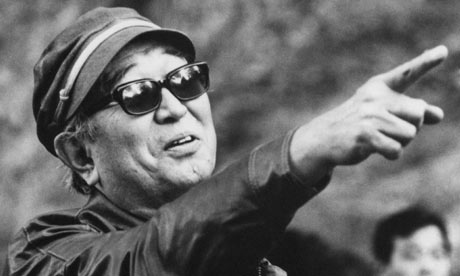
Akira Kurosawa's centenary has been marked by a Google Doodle today. Photograph: Cine Text / Allstar
1) Drunken Angel (1948)
The youngest of eight children, Akira Kurosawa grew up in Tokyo where, at the age of 26, he began an apprenticeship at PCL studios. His first features as director, made in wartime, had nationalistic strains but No Regrets for Our Youth (1946) and Drunken Angel, about an alcoholic Tokyo doctor trying to get a stagnant pool drained, established a critical engagement with contemporary Japan.
2) Stray Dog (1949)
Drunken Angel inaugurated Kurosawa's working relationship with the actor Toshiro Mifune, which was repeated in this picture, with Mifune playing a policeman on an increasingly obsessive quest to retrieve his stolen gun. Set during a sweltering summer, Kurosawa's breakthrough film confirmed both his feel for contemporary Tokyo and his admiration of American genre pictures.
3) Rashômon (1950)
Recognised at Venice and the Oscars, Rashomon was not just Kurosawa's international breakthrough but the standard-bearer for new Japanese cinema. Recounting a bandit's (Mifune) ambush of a couple in a forest from several contradictory perspectives, its radical challenge to conventional narrative was complemented by beautiful, often stylised photography.
4) The Idiot (1951)
Slashed - to Kurosawa's enduring indignation - from its original length
of more than four hours, The Idiot was an early example of the director's adaptation of European literary sources to a Japanese context. Dostoyevsky's novel is relocated to Hokkaido, with Masayuki Mori as a recently released war criminal and Mifune his temperamental friend.
5) Ikiru (1952)
Centred on the final phase of a middle-aged salaryman's life, Ikiru show Kurosawa in full-blooded humanist mode. Takashi Shimura is the bureaucrat whose diagnosis of terminal cancer initially sends him into alienated despair before he finds a kind of redemption in a project the hero of Drunken Angel might have appreciated.
6) Seven Samurai (1954)
Seven Samurai, about a band of masterless samurai defending a village from bandits, arguably remains Kurosawa's towering cultural achievement. The biggest movie Japan had seen at the time, in terms of budget, production and box-office takings, it was also an enormous influence on Western cinema, as well as enormously influenced by it.
7) Throne of Blood (1957)
Transferring Macbeth to medieval Japan reaps dividends: this is one of the most impressive of all screen adaptations of Shakespeare, streamlining the narrative and expressing it through a series of bravura visual coups. Mifune is the ambitious samurai at the centre of a stark world laced with violence, beauty and irony.
8) The Hidden Fortress (1958)
Another period samurai adventure starring Mifune, The Hidden Fortress was another Kurosawa masterclass in the conflation of Japanese and
Hollywood tropes. The filmmaker's first widescreen effort, its story of a ragtag band trying to transport a princess to safety and eventually help her free her land is the acknowledged source for George Lucas's Star Wars.
9) Yojimbo (1961)
Similarly, Yojimbo drew on film noir and classical Westerns only to
prove massively influential itself, with Sergio Leone taking inspiration from its tale of an effectively nameless lone warrior playing one side of criminals off against another. A funnier, more grotesque sequel, Sanjuro, followed the next year.
10) Ran (1985)
The final decades of Kurosawa's life saw his greatest struggles for artistic freedom, prompting him to look beyond Japan for funding. Shot in colour and influenced by King Lear, Ran, his final grand-scale project, was not without professional and personal cost but confirmed his abilities remained intact.
11) (and one for luck …) Dreams (1990)
One of three more films that followed before his death in 1998, Dreams was an elliptical collection of tales based upon Kurosawa's actual dreams. This is Crow.
Google stoppar Kina-censur
Uppdaterat 2010-03-22 22:56. Publicerat 2010-03-22 20:44
Internetjätten Google meddelade på måndagen att företaget har stoppat censuren av sin kinesiska sökmotor Google.cn. Genom att vidarelänka från Google.cn till Hongkongbaserade Google.com.hk ska användarna slippa censuren, skriver nyhetsbyrån Reuters.
”Den kinesiska ledningen har under våra diskussioner varit kristallklar med att självcensur är ett icke förhandlingsbart juridiskt krav”, skriver Google vidare.
Företaget avser dock att fortsätta med försäljning och med sitt forsknings- och utvecklingsarbete i Kina, enligt inlägget.
Beskedet kom strax efter det att USA:s utrikesdepartement meddelat att man hade ”mycket starka indikatorer” på att Google inom kort skulle göra ett viktigt uttalande.
I fredags skrev kinesiska medier att Google kommer att lägga ner sin verksamhet i Kina den 10 april, men från Google självt hördes då ingen kommentar.
Företaget har dock tidigare varslat om att det ska lämna Kina efter avslöjanden om cyberangrepp och intrång i e-postkonton på Gmail, tillhöriga kinesiska människorättsaktivister.
Intrången är en av flera frågor som ökat spänningen mellan USA och Kina inom diplomati och handel. Google har tidigare fått kritik för att ha böjt sig för kinesiska krav och infört ett filter på google.cn.
När DN.se skrev in Google.cn i adressfältet vidarelänkades vi direkt till Google.com.hk. Frågan är nu vad de kinesiska myndigheternas motdrag blir.
En antydan i den vägen kom senare på måndagen då Kina gick ut och deklarerade att Googles beslut att häva censuren är ”helt fel”, enligt en rapport från statliga kinesiska nyhetsbyrån Nya Kina. Enligt nyhetsbyrån anser Kina också att Google nu ”brutit mot ett skriftligt löfte”.
Samtidigt förklarade Vita huset att man är ”besviken” över att Google och Kina inte lyckats träffa någon överenskommelse.
TT-AFP-Reuters-DN.se
internationella regissörer till stöd för häktade Panahi
Stockholms Internationella Filmfestival Junior söker volontärer
Nu söker vi volontärer till årets Juniorfestival!
Gillar du att arbeta med barn och trivs med fart och fläkt? Vi söker volontärer som kan jobba på biograferna, men även gästvärdar och chaufförer. Maila din ansökan till [email protected].
Hollywood och Bollywood mot piratmarknaden
DN
http://www.dn.se/kultur-noje/film-tv/hollywood-och-bollywood-i-gemensam-piratjakt-1.1065181Uppdaterat i dag. 10:33. Publicerat i dag. 09:58
Världens två största filmindustrier, amerikanska Hollywood och indiska Bollywood har gått samman för att med gemensam kraft jaga och bekämpa såväl upphovsrättsintrång på nätet som den mer traditionella piratmarknaden på gatorna.
Det är intresseföreningen MPAA (The Motion Picture Association of America) som gör gemensam sak med sju indiska filmbolag för att begränsa piratverksamheten i Indien, rapporterar nyhetsbyrån AP. Alliansen sammanfaller med att Hollywood i allt högre utsträckning försöker slå sig in på den indiska marknaden. Sedan tidigare har MPAA skapat liknande antipiratallianser i USA, Europa och Hong Kong.
I den nya "piratoffensiven" kommer alliansen dels att inrikta sig på att stoppa "avfilmning" i biosalonger, vilket ligger bakom 90 procent av alla piratskivor som säljs på de indiska gatorna, som i sin tur utgör 60 procent av den indiska filmförsäljningen, enligt KPMG.
Dessutom har alliansen en uttalad målsättning att sätta ökad press på internetleverantörer och politiker för att arbeta fram mer effektiva antipiratlagar. Internetanvändningen i Indien har ökat i takt med bredbandsutbyggnaden.
Det är alltså ingen tillfällighet att MPAA nu inriktar sig på just Indien. Förutom att den indiska filmbranschen ständigt utvidgas har Bollywood en historia av så kallade copycat-produktioner som sticker Hollywood i ögonen.
Ett av senare års mer uppmärksammade exempel var filmen "Hari Puttar - A comedy of terrors" som utan framgång stämdes av Hollywoodbolaget Warner Bros. De ansåg att huvudrollsinnehavarens namn påminde på tok för mycket om en viss tonårstrollkarl.
Men det finns även flera lyckade samarbeten över nationsgränserna, som Oscarsvinnaren "Slumdog Millionaire" och "My name is Khan".
Parallellt har stora indiska filmbolag, som UTV Motion Pictures och Reliance Big Pictures, börjat köpa in sig i Hollywood. Bland annat har de indiska bolagen investerat i Steven Spielbergs bolag Dreamworks.
- Folk blir allt mer likasinnade, säger MPPA-ordföranden Dan Glickman till AP och hänvisar till en studie av Ernst & Young som visar att piratförsäljningen kostade den indiska filmindustrin närmare en miljard bara under 2008.
Glickman fortsätter:
- Det här är ett land med en miljard människor där man älskar film mer än någon annanstans i världen. Vi vore galna om vi inte försökte slå oss in på den här marknaden.
I samma AP-artikel berättar Sanjeev Lamba, chef på bolaget Reliance Big Pictures, hur filmsatsningen "3 idiots" blev en finansiell framgång mycket tack vare att bolaget aktivt och aggressivt bekämpade piraterna i realtid.
Enligt Lamba lyckades man stoppa tio miljoner illegala nedladdningar. Men det var ingen enkel match. Gruppen som arbetade med lanseringen av "3 idiots" ska ha hittat en ny illegal kopia på nätet var femte minut.
Henrik Arvidsson
Statsvänlig film hyllar kommunistparti
SR Måndag 22 mars 2010 07:43
 Jackie Chan i 2009 års Grundandet av en nation.
Jackie Chan i 2009 års Grundandet av en nation. Det kinesiska kommunistpartiet fyller 90 år 2011, och till jubileet planeras en extravagant hyllningsfilm. Kinas största statliga filmbolag, China Film Group, har gått i täten för en ny generation statsvänlig film som blandar blandar traditionell propaganda med nutida kändisglamour.
Det kinesiska kommunistpartiets 90-årsdag nästa år kommer att firas med filmpremiär och miljöerna för "Grundande av ett parti" är redan utvalda i ordförande Mao Zedongs hemtrakt nära Changsha i Hunanprovinsen.
Precis som hyllningsfilmen "Grundandet av en nation"" som kom ut lagom till Folkrepublekens 60-årsjubileum förra året ska filmen om kommunistpartiets födelse bäras upp av skådespelare som är kända från den kommersiella filmvärlden. I den förra spelade bland annat Jackie Chan, Jet Li och ett hundratal andra ur den kinesiskspråkiga skådespelargräddan.
Att synas i den här typen av partivänlig film erbjuder en möjlighet för filmstjärnor från Taiwan och Hongkong att skapa en kinavänlig image och på det sättet säkra relationerna med en stor filmmarknad.
Det finns tidigare exempel på att filmstjärnor straffats med dålig publicitet och arbetsförbud i Kina, som Tang Wei som förförde en japansk agent i Ang Lees Lust, caution och inte syntes i en ny film på nästan tre år.
Den kinesiska biografindustrin kontrolleras noggrant och anledningen till att "Grundandet av en nation" lyckades dra in över 400 miljoner kronor trots det något svårsålda ämnet var att över 60 procent av biljetterna var gruppbiljetter som förbokades av statliga företag och förvaltningar för deras anställda, och man kan anta att den kommande filmen för att fira kommunistpartiets 90-årsdag kommer att få samma draghjälp.
Hanna Sahlberg, SR Peking
[email protected]
Kino - fängelser, balettsalar och det allra innersta
Slutna rum och öppna dörrar
-fängelser, balettsalar och det allra innersta
 Filmen "en profet" är regisserad av Jacques Audiard. Huvudkaraktären Malik El Djebena spelas av Tahar Rahim
Filmen "en profet" är regisserad av Jacques Audiard. Huvudkaraktären Malik El Djebena spelas av Tahar Rahim I veckans Kino gläntar vi på dörren till slutna rum som få får tillträde till, men som vi gärna fantiserar kring. Vi möter även de som valt att öppna dörren till sitt innersta och visa upp sina liv för biopubliken.
I veckan går kritikerhyllade "En profet" upp på de svenska biograferna. Kino tittar närmre på fängelsefilmen som genre. En brutal, våldsam och mycket manlig värld som verkar vara oemotståndlig för filmskapare. Bland annat träffar vi X-cons förening Fängslande kultur för att försöka reda ut vad som är fängelsedramats oemotoståndliga charm.
Den danske regissören Nils Malmros saknar aldrig idéer till sina filmer. Sedan början av 70-talet har han gång på gång hämtat inspiration från sin barndom och uppväxt till sina långfilmer. Till exempel Kunskapens träd från 1981, som till och med räknas som dansk kulturkanon på filmområdet. I sin senaste film Kærestesorger skildrar han sin gymnasietid, och den olyckliga kärlekens våndor.
Att berätta om sig själv och sitt liv är inte ett grepp som dokumentärfilmaren Frederick Wiseman gillar. Följ med den legendariske regissören in på Parisoperans balettrepetitioner. Där är Wiseman en tyst iakttagare som med kameran visar hierarkierna, perfektionen och dansens verkliga pris.
Programledare: Roger Wilson
Verklighetens ”Inglourious Basterds”
http://www.dn.se/kultur-noje/film-tv/hans-landa-i-tarantinos-inglourious-basterds-fanns-pa-riktigt-1.1062784
Uppdaterat i dag. 11:59. Publicerat i dag. 11:09

All Over Press Christoph Waltz som filmvärldens svar på Karl Wolff.
Tarantinos ”Inglourious Basterds” skildrar andra världskriget på ett högst fantasifullt sätt. Men karaktärerna i filmen har en tydligare förankring i verkligheten.
Men några av filmens element kan ligga närmare verkligheten än vad filmens skapare var medvetna om. Den intelligenta SS-översten och ”judejägaren” Hans Landa, som spelas av Oscarsvinnaren Christoph Waltz, har en påtagligt verklig historisk motsvarighet.
I The International Herald Tribune skriver historikern Istvan Rev att karaktären Hans Landa löst bygger på en av tredje rikets högsta officerare. SS-mannen Karl Wolff har många likheter med Hans Landa, som i filmen förhandlar om immunitet i utbyte mot att ”the basterds” får döda Hitler och det tyska rikets högsta ledning.
I likhet med Tarantinos karaktär gjorde också Wolff en överenskommelse med de allierade när krigslyckan vänt för de tyska makterna. Wolff ansvarade för det område i Italien som tyskarna hade i besittning, och var tillsammans med andra SS-officerare delaktig i deporterandet av judar till koncentrationslägren. Vid rättegången i Nürnberg klarade sig Wolff undan hårdare straff genom att förse de allierade med bevis mot andra nazister.
Karl Wolff kapitulerade, tillsammans med hundratusentals soldater, till den blivande CIA-chefen Allen Dulles som under förhandlingarnas gång fattat tycke för SS-officeren.
Historikern Istvan Rev skriver i The International Herald Tribune att Dulles fann Karl Wolff aristokratisk, förtroendeingivande och även ”Goetheliknande”. Något som även det kan späda på Wolffs likhet med den fiktive Hans Landa.
Daniel Gustafsson
Tortyr i fransk tv-sändning
http://www.dn.se/kultur-noje/film-tv/tortyr-i-fransk-tv-sandning-1.1062813
Uppdaterat i dag. 12:45. Publicerat i dag. 11:27

Foto: AFP Photo/France 2 En bildsekvens från "the Game of Death" där deltagarna torterar vad de tror är andra deltagare med elchocker.
Fransk tv tar underhållningen till en helt ny nivå. I ”The Game of Death” utsätter deltagarna en man för elchocker tills han skendör.
”De ville inte göra det, de försökte övertyga den auktoritära personen om att de borde sluta, men de klarade inte av att göra det”, säger Christophe Nick, en av producenterna, till AFP.
Tillsammans med en grupp psykologer samlade han ihop 80 volontärer och sade till dem att de skulle vara med i ett pilotavsnitt av ett nytt tv-program. Varken deltagarna eller publiken kände till att programmet inte var på riktigt.
64 av de 80 deltagarna utsatte personen för elchocker till dess att han skenbart dog. Enligt Reuters skrattade deltagarna vid åtminstone ett tillfälle under programmets gång och endast 16 deltagare lämnade tävlingen.
”Jag var orolig för deltagaren, men samtidigt rädd för att förstöra programmet”, säger en deltagare till AFP.
En annan deltagare, vars judiska farföräldrar hade förföljts av nazister, förvånades över sitt egna beteende.
”Jag har alltid frågat mig hur de (nazisterna) kunde göra det. Hur de kunde lyda sådana order. Och där stod jag och lydde dem själv”, säger hon.
Programmet är inspirerat av Milgramexperimentet, som på 1960-talet ville utreda vilka funktioner som möjliggör att människor deltar i massmord. Experimentet utvecklades med bakgrund i förintelsen och rättegången mot Adolph Eichmann.
En psykolog uttalar sig skeptiskt till AFP över värdet av programmet, eftersom deltagarna skrev kontrakt på att de skulle lyda programledarens instruktioner. Men enligt producenterna var det just det som var tanken med experimentet.
”När televisionen bestämmer sig för att missbruka makt kan den göra vad som helst med vem som helst. Den har en fruktansvärd makt”, säger tv-producenten Christophe Nick, och drar paralleller till Stanley Milgrams experiment.
"I Milgrams fall lydde 62 procent av deltagarna order; med televisionen är det 81 procent", säger han till Reuters.
Karl Dalén
Sergei Paradjanov: film-maker of outrageous imagination
Sergei Paradjanov made some of the most beautiful films ever seen, writes Elif Batuman. His reward was to be sent to the gulag for 'surrealist tendencies'
- Elif Batuman
- The Guardian, Saturday 13 March 2010
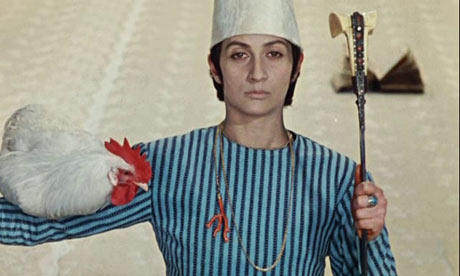
A still from Paradjanov's 1969 film The Colour of Pomegranates. Photograph: BFI
Between his abandonment of socialist realism in 1964 and his death from lung cancer in 1990, Sergei Paradjanov made four of the weirdest and most beautiful movies ever seen. An ethnic Armenian, Paradjanov was born in Soviet Georgia in 1924. His mother was "very artistic": she "used to adorn herself with Christmas tree decorations and curtains and join her friends on the roof to enact legends". In 1947, Paradjanov spent a brief stint in a Georgian prison for committing "homosexual acts" (which were illegal under Soviet law) – with, of all people, a KGB officer. He later disavowed the seven films he shot in the 1950s and early 1960s. In 1962, he saw Tarkovsky's Ivan's Childhood and completely changed his artistic method, which had previously been quite normal.
The first film in Paradjanov's mature style, Shadows of Forgotten Ancestors (1964), brought him instant fame and notoriety. Filmed in the Ukrainian Carpathians, in a regional dialect that couldn't be understood by most Russians (Paradjanov refused to have it dubbed), Shadows tells the story of the doomed love of Ivan and Marichka, children from feuding families. Marichka drowns relatively early in the film, and critics have justly celebrated its representation of lost childhood love, brutal slayings and various Ukrainian folk ceremonies. To me, however, the most moving and surprising aspect of the film is the depiction of Ivan's second marriage.
After Marichka's death, Ivan lapses into grief and madness – this part of the film is shot in black and white – before finding himself attracted to the comely Palagna. (They share an erotically charged moment when she is holding a horse's hoof for him to hammer on a shoe.) The two are united in a bizarre ceremony which involves blindfolds and a wooden yoke. They seem happy at first, but Ivan grows distant and brooding, and Palagna is unable to conceive a child. One gorgeously composed scene shows the couple at the dinner table: both are facing the camera, and a calf is sitting under the table, looking cramped and miserable. Every unhappy family is unhappy after its own fashion – but how recognisable and universal Paradjanov renders this highly particular unhappiness! Both the spouses, it turns out, are dabbling in sorcery: Ivan has taken to inviting the spirits of the maimed and drowned into their home, hoping that he may be visited by Marichka; Palagna, meanwhile, wanders naked in a forest, exhorting the dark forces to bring them a child. In a mind-blowing convergence of literal and symbolic narratives, Palagna starts cheating on Ivan with the local sorcerer. Then the marriage really hits the rocks.
Shadows has the most legible storyline of all Paradjanov's films. He followed it with The Color of Pomegranates (1969), a 90-minute, Armenian-language meditation on the life of the 18th-century poet-troubadour Sayat Nova. The film consists of a series of dreamlike tableaux, designed to "recreate the poet's inner world". Particularly astounding are the courtship "scenes" in which the poet and his lover are both played by the lithe, unearthly Sofiko Chiaureli: a trick that renders visual and literal the union of the poet-lover and the beloved-God in eastern mystical poetry. The only "narrative" is provided by the successive replacement of a small boy with a youth, a monk and an old man: it's like an illustration of the riddle of the sphinx.
Though Paradjanov was eight years older than Tarkovsky, he described the younger film-maker as his "teacher and mentor", and Pomegranates clearly invites comparison with Tarkovsky's Andrei Rublev (1966), based on the life of the great 14th-century Russian monk and icon painter.
In Andrei Rublev, nearly 200 minutes of black-and-white narrative are followed by a meditative colour slideshow of Rublev's icons. Pomegranates is a hallucinatory mash-up of these two types of material: a life story told in brilliantly coloured and animated Persian miniatures. The actors, dressed in outlandishly detailed handmade costumes, move as if by some strange clockwork, performing repetitive stylised gestures, tossing a golden ball in the air or gesturing enigmatically with some symbolic-looking object: a seashell, a candle, a rifle. Paradjanov himself compared Pomegranates to a "Persian jewellery case": "On the outside, its beauty fills the eyes; you see the fine miniatures. Then you open it, and inside you see still more Persian accessories." An accurate description: every last article and action in the film seems precisely placed, exquisitely detailed and designed to serve a particular purpose in some unknown ritual.
The Color of Pomegranates was the last film Paradjanov would make for 15 years. In 1973, after indictments for art trafficking, currency fraud, "incitements to suicide" and surrealist tendencies, the director was sentenced to five years in a maximum-security gulag, where his duties included sewing sacks. An indomitable spirit, he became an expert at making dolls from leftover sackcloth. He made a doll of Tutankhamen and another of his friend Lilya Brik. Through the offices of Brik, Tarkovsky and other powerful friends, Paradjanov was released one year early, in 1977. He wasn't allowed to work, and lived in utter destitution in Tbilisi. At one point, Tarkovsky gave him a ring to pawn, but Paradjanov decided to keep it as a souvenir of their friendship.
In the early years of the thaw, Paradjanov finally returned to the studio and made his last two movies: The Legend of Suram Fortress (1984) and Ashik Kerib (1988). Suram Fortress, shot in Georgia, is a Poe-like patriotic yarn involving an accident-prone fortress in Tbilisi that is destined to remain standing only when a young hero has been buried alive in its walls. The fortress also apparently has to have a giant cart full of eggs dumped into the foundation and crushed with a sledgehammer – a peculiarly disturbing and indelible image.
Based on Mikhail Lermontov's retelling of a Turkic folktale, Ashik Kerib is the story of a troubadour obliged to spend 1,001 days wandering the land, in order to make enough money to marry his beloved. The hero is played by Yuri Mgoyan, a picturesque 22-year-old Kurdish "hooligan" and car thief recruited by Paradjanov for his "plasticity". (In one behind-the-scenes clip, Paradjanov demonstrates this plastic quality by wrapping a blanket around the young man's head and declaring: "A complete metamorphosis! He's a pharaoh!") These last two films somehow manage to seem at once naive and sophisticated, with the hyper-realism of a puppet show. Mastiffs rest their great weary heads on their paws, as evil henchmen force a slave to toss pomegranates for them to impale on their sabers. A gigantic flock of running sheep, filmed from overhead, shifts into strange formations. Endless rites and rituals unfold to unheard-of music.
Ashik Kerib is the only one of Paradzhanov's films to have a happy ending. The lovers are reunited and a white dove alights on a movie camera, representing Tarkovsky, to whose memory the film was dedicated. But to me, the outrageousness of Paradjanov's imagination is best encapsulated by the final scene of The Color of Pomegranates, in which death comes to the poet in the form of a shower of live chickens. Dressed in white, the troubadour lies on the floor, surrounded by candles; the chickens, who seem to be upset about something, fall on to him from a great height, dispensing a flurry of white feathers and extinguishing the candles. It's not the way you would expect a national poet, or anyone really, to depart this world – but Paradjanov makes it look inevitable.
• The Paradjanov Festival 2010 runs in London and Bristol until 9 May. paradjanov-festival.co.uk
The greatest film scenes ever shot (?)
källa:
http://www.guardian.co.uk/film/2010/mar/14/greatest-movie-scenes-psychoWe all have film sequences that stick in our minds. Some are shared by many – such as the shower scene from Psycho – others are particular to us. Here our film critic and a panel of leading movie-makers reveal their favourites. What are yours?
-
- Philip French
- The Observer, Sunday 14 March 2010
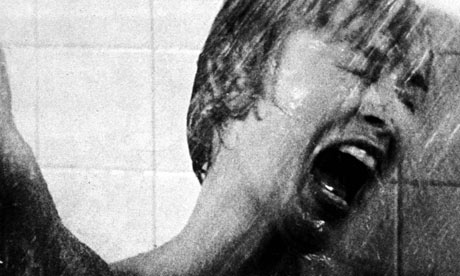
Janet Leigh in Psycho. Photograph: Allstar
Who will ever forget the first time they saw the 45-second shower-room murder in Hitchcock's Psycho? I remember 1959 and 1961 as the years when my first two children were born. But the first thing that comes to mind about the year in between was seeing Psycho, which I'd been looking forward to since a radio programme I'd produced the previous October, when Hitchcock had enticingly described Psycho as "my first real horror film". Entering the Plaza, Lower Regent Street, the day the film opened, I passed the cardboard cut-out of Hitchcock in the foyer, from which a tape recording of the Master's familiar Leytonstone undertaker's voice warned us what would happen if we gave away the ending.
Half an hour into the movie, when Janet Leigh stared out at us from the floor, a man sitting in front of me staggered into the aisle and vomited: testimony to the sensitive stomachs of the time, or (as several other people I know witnessed a similar incident at the Plaza that week) evidence that Paramount's publicity department had hired a method actor for the film's opening run?
Such indelibly iconic moments have been part of moviegoing since the Lumière brothers' first public screening of a dozen short scenes in December 1895. One of them had the audience recoiling from a train entering a station, another had them chuckling when a cheeky boy tricked a gardener into spraying himself with a hosepipe. People judge a movie by the strength of its story and overall impact, but ultimately what they remember are individual moments and sequences. This perhaps reflects the very nature of film, which is a rapid succession of still pictures that provide an illusion of motion. And until the coming of cassettes and DVDs, few of us were able to see a picture over and over again or re-view a sequence. So we had to replay it in our minds, and naturally we'd often get it wrong. Which is how "Play it again, Sam" entered the language instead of: "Play it, Sam, play 'As Time Goes By'."
James Stewart seems to have been thinking of this approach to cinema when he talked to Peter Bogdanovich about his craft: "What you're doing is… you're giving people little… little, tiny pieces of time… that they never forget." This is echoed by Walker Percy in his 1961 novel The Moviegoer. Some people, his narrator says, "treasure memorable moments in their lives: the time one climbed the Parthenon at sunrise", but "what I remember is the time John Wayne killed three men with a carbine as he was falling to the dusty street in Stagecoach, and the time the kitten found Orson Welles in the doorway in The Third Man". Likewise Jean-Dominique Bauby, the paralysed French writer, describes in The Diving Bell and the Butterfly how he'd lie in the hospital recreating favourite scenes from Touch of Evil, Stagecoach, Moonfleet and Pierrot le fou. Canny film-makers have cottoned on to the idea, like James Cameron, who says: "You try to create one or more emotional, epiphanous moments within a film."
These moments come in many forms – simple, complex, lyrical, violent, gentle, witty, romantic, revelatory – and, if they stick, become as real as any other memory. They can range from the split-second close-up of the suave spy's missing half-finger in Hitchcock's The 39 Steps to the protracted pursuit of Cary Grant by the crop-dusting plane in North by Northwest, from the in-your-face eye-slicing in Buñuel's first silent movie, the avant-garde Un Chien Andalou, to the puzzling sequence of the Chinese businessman's mysterious box in the same director's mainstream success Belle de Jour 40 years later. Like your favourite jokes, your cherished movie moments reveal something about you and, if shared, they can be the beginning of a beautiful friendship, especially if one of them is the final sequence in Casablanca that features that line.
My own favourites? The Odessa Steps sequence from Battleship Potemkin. The love at first sight between John Wayne and Maureen O'Hara in The Quiet Man, the lust at first sight between Fred McMurray and Barbara Stanwyck in Double Indemnity. The children running through the woods to see a train in Pather Panchali and finding grandmother dead on the way back. The cruelly comic soccer match in Loach's Kes. Donald Sutherland and Julie Christie making love in a Venetian hotel in Don't Look Now. The slow-motion mayhem let loose in The Wild Bunch after William Holden says: "If they move, kill 'em!" Perhaps my single favourite moment comes in Citizen Kane, where Kane's now elderly friend Bernstein tells the reporter about an epiphanic memory of seeing a girl in a white dress on the New Jersey ferry in 1896. "I'll bet a month hasn't gone by since that I haven't thought of that girl." It's a moment about remembering a moment, and the actor Everett Sloane makes it so vivid we think we've seen that girl ourselves.
THE FRENCH CONNECTION (1971) - THE SUBWAY CHASE
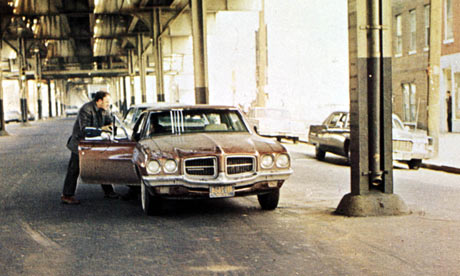 Gene Hackman gets behind the wheel for The French Connection's famous car chase. Photograph: Ronald Grant Archive
Gene Hackman gets behind the wheel for The French Connection's famous car chase. Photograph: Ronald Grant Archive
Chosen by Ryan Fleck, the American indie film director, writer, editor and cinematographer, best known for co-writing and co-directing with partner Anna Boden Half Nelson and Sugar correct(out now on DVD).
The villain's on the elevated subway. You think he's going to get away because a person on foot can't keep up with the subway… But Gene Hackman jumps in a car and starts chasing the subway, riding underneath it, going at 80mph, swerving in and out of traffic. I first saw this scene on video when I was 18 or 19, in college. I loved it.
In action scenes nowadays you can chalk everything up to some kind of computer effect. Audiences no longer really believe that what they're seeing exists anymore. When The French Connection was made that notion didn't really occur to people. What you saw was usually really happening in front of the lens. It was raw. I did a little bit of research about how they shot the scene. Phenomenal. Basically they just did it. There was no security blocking off other traffic, just Hackman in a car with a camera mounted on the front. They went crazy, lost their minds, and went for it.
It was the kind of thing that you just would never get away with these days. I'm editing a movie right now that has a teenager walking on the Brooklyn Bridge, considering suicide. He steps out on to a ledge, over traffic… It never even occurred to put the actual kid out on the ledge, on a bridge, over traffic because we knew there was no way authorities would let us do that. So there's camera trickery. Back in the 70s we'd have just thrown a child out over the ledge, seen what happened, and shot it.
JULES ET JIM (1962) - THE BICYCLE SCENE
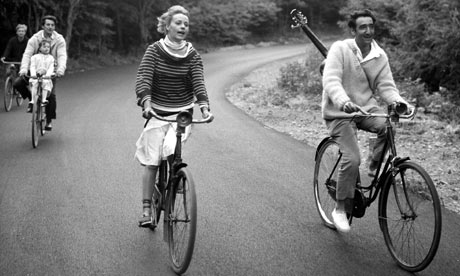 Truffaut's Jules et Jim. Photograph: BFI
Truffaut's Jules et Jim. Photograph: BFI
Chosen by Ken Loach, writer/director of the influential docudrama Cathy Come Home, and director of nearly 30 films including Kes, Riff-Raff, My Name is Joe and Looking for Eric. He won the 2006 Palme d'Or at Cannes for The Wind that Shakes the Barley.
This scene always cheers you up. Jeanne Moreau and the two guys on their bicycles in the sun in France, the music that goes with it… Partly it evokes what you imagine to be the perfect French vacation but also it's a very fine bit of film-making.
When you're in the business and have been in the business a long time, you tend to dismember about 99% of films as you're watching. The time when you used to watch a film just for enjoyment is difficult to recapture. But just occasionally a film will transcend that. The sense of enjoyment with this trio on their bicycles is perennial. It's completely evocative of that carefree young moment, the age when people are carefree. And then of course, for these three, it will all be ruined by the war.
The song that was composed for the film – "Le tourbillon" – became very famous. I'd sing it for you if I wasn't surrounded by colleagues who would take the piss. I think film music that tells you what to think is cheap – the film should do that without that prompting. But in Jules et Jim it is music in relation to the images, the music has an independent existence and there's a relationship between the two.
It is not something subterranean, there to steer you through every second and push you into feelings that the pictures don't generate themselves.
ALL ABOUT EVE (1950) - BILL'S BIRTHDAY PARTY
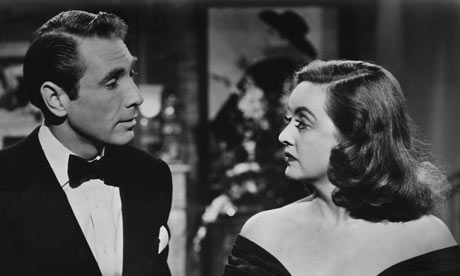 Bette Davis and Gary Merrill in All About Eve. Photograph: British Film Institute
Bette Davis and Gary Merrill in All About Eve. Photograph: British Film Institute
Chosen by Beeban Kidron, who came to international attention directing the BBC's adaptation of Jeanette Winterson's novel Oranges Are Not the Only Fruit in 1990. She has since directed several feature films including Bridget Jones: The Edge of Reason and To Wong Foo, Thanks for Everything, Julie Newmar.
Every single line in this scene is quotable. It's the most beautifully written thing, from an era of cinema very closely knitted to the theatre, when the words were supposed to evoke things rather than just be things for people to say while the pictures were going on. That's something that's very often lost 60 years later.
Margo, played by Bette Davis, is a great Broadway actress at the pinnacle of her power: brilliant, sophisticated, bitchy. Her assistant Eve, meanwhile, played by Anne Baxter, is simpering, beautiful and very, very ambitious. Eve is trying to replace Margo, trying to get her next part on Broadway and take her lover, Bill. This is the scene where Margo finally loses her rag, having waited upstairs for Bill to throw him a party before discovering that he's been downstairs with Eve for 20 minutes.
The scene sums up the central themes of the film, to do with Margo's insecurity about age and about the way that Eve is eating into her life. This is referred to in the dialogue all the time: Margo finds Eve and Bill talking and immediately asks if she can join in – "Or isn't it a story for grown-ups?" Bette Davis, despite being so powerful, gives a phenomenal performance of insecurity. That is very, very rarely drawn in the cinema.
The question of ageing and of being replaced by the younger, more beautiful woman is something we can still understand today.
JASON & THE ARGONAUTS (1963) - THE SKELETONS SCENE
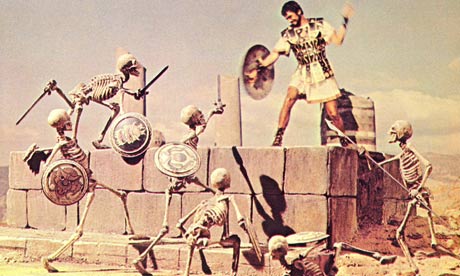 Ray Harryhausen's Jason & the Argonauts Photograph: Everett Collection / Rex Feature
Ray Harryhausen's Jason & the Argonauts Photograph: Everett Collection / Rex Feature
Chosen by Nick Park, Oscar-winning animator and writer/director of the Wallace and Gromit films.
As a boy I was into monsters, heroes going off on adventures – and stop-motion animation. I saw trailers for this film and it seemed to be everything I wanted. I remember being at a school fair, just before Christmas, and being desperate to get home to watch it.
The scene that stood out the most, that I found both horrifying and enthralling, was the skeleton fight at the end. The heroes are all live action and the monsters are all done with stop-frame animation. It was a terrific technical feat – I think there were eight animated skeletons or more, cut together quite seamlessly with the live action. The whole choreography of it was amazing. But the story, too, really caught my imagination. These skeletons were planted like seeds, by a wizard chap spreading dragons teeth, and then dead soldiers grow up to fight the Argonauts. So exciting.
At around the same time I saw Ray Harryhausen, the animator, explain on television how he had done the skeletons. I immediately went and built my own models with wire and foam – I think I was planning to film something with my friends, live action, cut together with a sea monster made out of a coat hanger and nylon tights.
Disney films didn't make me want to go home and do it myself because it was shrouded in mystery and technique. But when I saw the skeletons in Harryhausen's film I wanted immediately to do it myself, because you got a sense of how it might be done.
2001: A SPACE ODYSSEY (1968) - THE FINAL SCENE
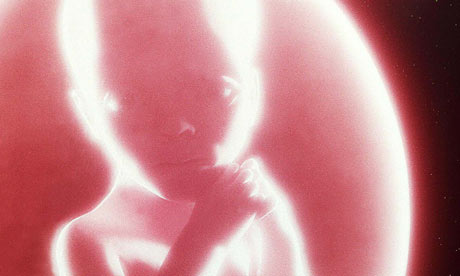 The Star Child from 2001: A Space Odyssey. Photograph: Kobal
The Star Child from 2001: A Space Odyssey. Photograph: Kobal
Chosen by Stephen Poliakoff. After starting out as a playwright, Poliakoff turned to writing and directing television dramas including Shooting the Past, Perfect Strangers and the award-winning The Lost Prince. His feature films include Hidden City and most recently Glorious 39.
Still, after 40 years, people are arguing about the ending of 2001: A Space Odyssey. What the ending means to the film. The computer taking over, the menacing computer howl, the foetus – it has passed into cinema folklore. Science fiction was not a genre that attracted me much, and it was very unsexy in the 1960s. But Kubrick's film was the most original I had ever seen. It came at me for the first time, completely alone, in a cinema on a summer afternoon in 1968. I was 15, and it made an extraordinary impression on me. There was a lot more mainstream "auteur cinema" than there is now, Hollywood studios producing personal films. Nevertheless Kubrick stood alone, a titanic figure that obsessively made films, under great secrecy, and with nobody interfering.
I had never seen such a bold use of cinema, and certainly never such an incredibly obscure ending. To have spent all that time and money and to have the daring – some would say foolhardy daring, but nevertheless a magnificent daring – to end the film on such an elusive and obscure note, I found it amazing as a 15-year-old that anybody should have the balls to do that. It excited me and changed my whole view of what you could do as a writer, whatever medium you were attempting – Kubrick's aspiration to be original. Now it's been much imitated but 2001 was extraordinarily ahead of its time, and has continued to survive and influence generations.
TAXI DRIVER (1976) - THE MIRROR SCENE
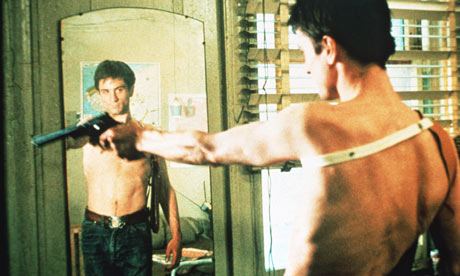 Robert De Niro as Travis Bickle in Taxi Driver. Photograph: British Film Institute
Robert De Niro as Travis Bickle in Taxi Driver. Photograph: British Film Institute
Chosen by Stephen Woolley, the award-winning producer best known for his collaborations with director Neil Jordan including Interview with the Vampire and The Crying Game. Recent projects include How To Lose Friends and Alienate People and the forthcoming Made in Dagenham. In 2005 he made his directorial debut with Stoned.
I remember seeing Taxi Driver for the first time in Paris in the 70s. The taxi gliding across New York's wet streets, smoke coming out of the subways, it was all incredibly delicious. It had this thundery Bernard Herrmann score, and when Robert De Niro did his "are you talking to me?" sequence in front of the mirror you suddenly sensed the degree of anger there. It was all bottled up until he explodes with this bravura performance. It's very clever, very economical, everything concentrated on his eyes.
Sequences like this are not only successful because they are so beautifully created but also because they often come at a point in a film where you begin to realise where it's going, you think, "oh my god, I know what this is about". Here you become aware that not only is Travis Bickle schizophrenic but he's aware of his own schizophrenia. He's like a genie in a bottle and you're waiting for him to let the genie out – which he does brilliantly in that horrific sequence later on where he shoots Harvey Keitel's character and saves Jodie Foster's.
The scene was improvised but De Niro had tried out a version of it in an earlier film he made with Brian De Palma, I think it's called Hi Mom! I didn't see it until years after watching Taxi Driver and I remember thinking "I can't believe it – the thing he does in Taxi Driver!"
CARRIE (1976) - THE BLOOD AT THE PROM SCENE
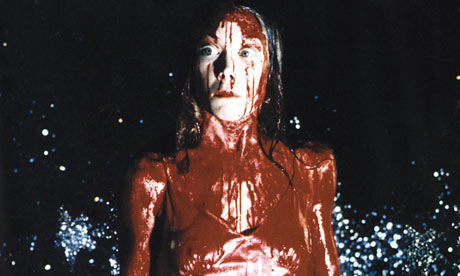 Sissy Spacek in Carrie. Photograph: Ronald Grant
Sissy Spacek in Carrie. Photograph: Ronald Grant
Chosen by Edgar Wright, who co-created Channel 4's Spaced, and has collaborated with comedian Simon Pegg on hit films Shaun of the Dead and Hot Fuzz. His latest directing project, Scott Pilgrim vs the World, is out later this year.
I always describe Carrie as the Grease of horror movies: it resonates with all ages because everybody remembers their awkward teenage phase and can watch it and say – I was the bully or the victim or the person who did nothing. It explores how apocalyptic your rage can be as a teenager. Carrie's not a killer, she's a girl who has been bullied and through a terrible confluence of events ends up burning the school down.
It's also unusual for a horror film. It doesn't have someone being killed every 20 minutes and then a climax – it builds to one huge climax at the prom. School bullies have fixed the prom so that Carrie White will win and they can humiliate her by tipping a bucket of pig's blood over her in front of the whole school. The scene and the excruciating build-up to it is one of the greatest set pieces of all time, full of suspense, with a monumental payoff.
A crane shot sets up the sequence so you know where everyone is positioned and that the bucket of blood is above Carrie and Tommy's heads. Once the plot is set in motion Pino Donaggio's score takes over. The resulting sequence is pure opera.
I first saw Carrie on VHS with my brother's friend when I was about 12. I obsessively read about horror movies and was dying to see it. I've watched it so many times since. De Palma planned the sequence for months and battled the studio over the time spent on filming it. But it was worth the blood, sweat and tears. It still leaves audiences speechless.
REAR WINDOW (1954) - THE OPENING SCENE
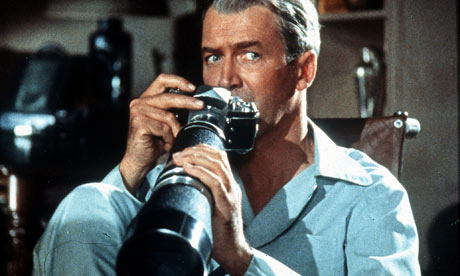 James Stewart in Rear Window. Photograph: Kobal
James Stewart in Rear Window. Photograph: Kobal
Chosen by Claire Denis, who made her directorial debut in 1988 with Chocolat. Subsequent films include Good Work and 35 Shots of Rum. Her latest, White Material, is out in the summer.
We don't have courtyards in France like they do in New York, where Hitchcock's film is set, but we have street buildings that are set very close to each other. From where I stand in my kitchen or my bedroom I can watch neighbours' windows very easily. I'm intrigued by voyeurism, about what is behind windows, and often in my films I stage a scene as if I was peeping in from outside.
The situation Hitchcock establishes in the opening scene of Rear Window is the ultimate voyeuristic situation. The character played by James Stewart has broken his leg, has nothing to do but linger behind his window and watch. He is passive but eager to find something – to be a witness of something, or to give his imagination something to chew on. As a spectator in a cinema theatre, you are a sort of prisoner in a chair, like he is.
The Girl With the Dragon Tattoo: feminist, or not?
källa:
http://www.guardian.co.uk/books/booksblog/2010/mar/15/girl-with-the-dragon-tattoo
Stieg Larsson's bestselling thriller The Girl With the Dragon Tattoo divided the critics, now the film has united them – and not in a good way
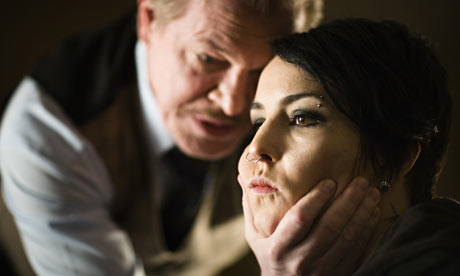
Sexist titillation? … Peter Andersson and Noomi Rapace in The Girl With the Dragon Tattoo. Photograph: Knut Koivisto
The debate has raged ever since Stieg Larsson's bestselling thriller, the first in a trilogy, was published in Sweden in 2005, a year after the author's death. The film, released in the UK last Friday – described by the Guardian's Peter Bradshaw as "a forensic procedural with explicit violence" – seems to have muddied the waters further.
Originally titled Men Who Hate Women, the book divided critics. Some saw Lisbeth Salander (the tattooed private investigator of the title) as a feminist avenging angel. Others criticised Larsson's graphic descriptions of the abuse and mutilation of women, judging the whole effort "misogynist".
It's all very confusing if you come to the story a bit after the event, which, like many, I have. Not being a thriller fan, I spurned the Dragon Tattoo bandwagon for a long time. When a book is as hyped as this, you have certain preconceptions: I imagined cliches and extreme violence. I was pleasantly surprised, then, to discover it is neither formulaic nor disturbingly graphic. And it was indeed Larsson's take on feminism that made it stand out as an original read.
The book promotes a very Scandinavian sort of equality. The message I took from it was that gender is irrelevant. We behave the way we do because of our individual characters and personal histories. In Larsson's world, it's the psychopaths who split the world along gender lines. And, boy, do they get their comeuppance.
But not everyone agrees. This f-word blog rounds up the initial reviews of the book, concluding that Larsson's rape and murder fantasies are little more than sexist titillation. Melanie Newman concludes that she has "difficulty squaring Larsson's proclaimed distress at misogyny with his explicit descriptions of sexual violence, his breast-obsessed heroine and babe-magnet hero".
Interestingly, in Joan Smith's original, positive review of the book in the Sunday Times she doesn't really take on Larsson's feminism, noting only that as an activist: "Larsson's other great preoccupation [alongside the fascist movement] was violence against women, and the scarcely believable horrors Blomkvist unearths are as rooted in misogyny as they are in fascism."
Others take the feminism as read. In the Times, Christina Konig describes it as combining "a contemporary feminist polemic with a good old-fashioned thriller". Feministing.com sees Lisbeth Salander as "basically a feminist avenger".
So far, the film has been less divisive. It has been universally panned as anti-women. In her review in Harper's Bazaar this month, Mariella Frostrup writes: "A potentially good mystery is lost in scenes – such as a violent rape – that dwell too much on what feels to me like Larsson's misogynistic fantasies." On the Arts Desk blog, Graham Fuller judges the film "scarcely feminist". He writes: "In frankly depicting Lisbeth's rapes and presenting an obscene array of photographs of murdered women in a killer's lair, it comes across as glibly indulgent of those visual horrors."
In the novel Larsson spares us many graphic descriptions, leaving a lot of the worst to our imagination. It seems, then, that the film has betrayed not only some of the book's original subtlety but also its feminism. I waited too long to read the book. I think I'll give the film a miss altogether.
”Videocracy” vann Tempo Documentary Award

Erik Gandini belönades med blommor, diplom, ära och 75 000 kronor när "Videocracy" vann Tempo Documentary Award. Foto: Fredrik Zillén
Erik Gandini tog hem Tempo Documentary Award och 75.000 kronor med sin film ”Videocracy” när priserna för Tempo Dokumentärfestival delades ut under lördagkvällen.
Tempo Pitch stoltserar med att vara Sveriges största pitchpris för dokumentärfilmer och ger segraren 75 000 kronor till projektet. I år var det sex projekt som hade först åtta minuter på sig, inklusive filmklipp, att presentera sin kommande film. Därefter var fanns ytterligare 12 minuter till frågor från juryn innan det var dags att kliva ner från scenen. Nytt för i år var att det hela avgjordes på scen med publik på plats i biografen Rio.
Stina Gardell, Ivan Blanco och Nur Tutal mitt under deras pitch.
Foto: Fredrik Zillén
Årets vinnare blev filmen ”Det bor en hemmafru i mig” av Nur Tutal, Ivan Blanco och producenten Stina Gardell. Juryn för Tempo Pitch bestod av: Jesper Bergom-Larsson, Filmregion Stockholm-Mälardalen, Tove Torbiörnsson, Svenska Filminstitutet och Charlotte Hellström, Sveriges Television, och motiveringen till priset var:
"Tempo Pitch 2010 - Sveriges största dokumentärpitchpris på 75 000 kr - går till ett modigt och laddat projekt som utmanar normer och värderingar. Vi vet inte var projektet kommer att landa, men våra förhoppningar är att denna starka trojka tar oss med på en inre såväl som en yttre resa. Vi önskar er lycka till på färden!"
Kvällens tyngsta pris, Tempo Documentary Award, som ger 75 000 kronor till regissören gick alltså till Eric Gandini för hans mycket uppmärksammade ”Videocracy”. Han fick priset med motiveringen: “Via ett mästerligt användande av TV-bilder som kan framstå harmlösa, men som döljer maktstrukturer och sprider en manschauvinistisk världsbild fri från innehåll och mening, visar regissören hur ett land har genomlevt en absurd och skrämmande kulturell revolution. Med stilistisk säkerhet, humor och en unik tillgång till sina källor utmanar filmskaparen en av Europas mäktigaste män på sin egen hemmaplan. Ett avgörande och skrämmande dokument om dagens Italien, och betydelsen av fria och opartiska medier.”
Här delades det även ut ett hedersomnämnande som gick till Linda Thorgren för filmen ”Blood calls you”.
Priset STHLM.DOC gick till Emelie Wallgren och Ina Holmqvist för ”Så nära” med motiveringen ”Medkänsla och närvaro följer filmen två tonåriga flickors turbulenta, intensiva och kärleksfulla vänskap i den gemensamma jakten på livets möjligheter och omöjligheter. Och på Bill och Tom.”
New Doc gick till Ahang Bashi för hennes film ”Paradiset”. Juryn motiverade sitt val med orden: “En vackert orkestrerat film av en lyhörd ny filmare som måste göra mer film. Filmen lyckas på ett osentimentalt sätt och med stor sensibilitet och humor kommunicera vårt behov av att bli förstådda. Helt genialisk! Priset New Doc går till Ahang Bashi förfilmen ’Paradiset’.”
Här valde juryn att även dela ut ett hedersomnämnande som gick till Johan Aaron Hjort för filmen ”Systrar”.
Tempo Radio Award tilldelades Robert Barkman för ”Jag heter Joakim” med motiveringen “För modet att överlämna sin mikrofon och genom det låta lyssnaren kliva rakt in i en ung pojkes vardag och eget universum. Robert Barkmans bearbetning av materialet är nydanade och så stilistiskt säkert att det inte märks, bara känns i magen.”
Två hederspris i radiokategorin delades också ut. Ett gick till David Rune för ”Bortom uppehållsvädet” medan det andra gick till Amanda Glans för ”Jag ringer dig ibland”.
 Efter ett inledningstal av Sveriges Radios VD Mats Svegfors fick Amanda Glans ta emot Susanne Björkman stipendiet. Foto: Fredrik Zillén |
Vinnaren av Folkets Bios kortfilmspris får sin film visad på minst 24 biografer och distribution på DVD. Priset gick till Ryszard Solarz för ”Bombay x-ray”. Motivering: “Vi får veta vad livets villkor innebär i en berättelse om vardagen, klimathotet, globaliseringen och framtiden. En film som skildrar ett skeende med absolut gehör.”

Alla vinnare.
2010-03-14 Fredrik Zillén
David Fincher aktuell att filma Stieg Larsson
http://www.dn.se/kultur-noje/film-tv/fran-fight-club-till-millennium-serien-1.1061957
Uppdaterat i dag. 15:52. Publicerat i dag. 10:04

Foto: Knut Koivisto Lisbeth Salander (Noomi Rapace) i "Flickan som lekte med elden".
”Fight Club”-regissören David Fincher är den hetaste kandidaten att ta sig an Stieg Larssons ”Män som hatar kvinnor” när Millenniumserien blir Hollywoodtrilogi. Spekulationerna om vilka skådespelare som ska göra huvudrollerna fortsätter.
Turerna kring fenomenet Stieg Larsson fortsätter, nu på andra sidan Atlanten. Regissören David Fincher, som legat bakom Brad Pitt-filmer som "Seven", "Fight Club" och senast "Benjamin Buttons otroliga liv", är den hetaste kandidaten att regissera Hollywoodversionen av "Män som hatar kvinnor" ("The girl with the dragon tattoo"). Det rapporterar det brittiska filmmagasinet Empire på webben.
Det är filmbolaget Sony som tillsammans med Yellowbird har rättigheterna till de engelskspråkiga filmversionerna av "Millennium"-trilogin och det är redan klart att tungviktaren Scott Rubin ("No country for old men" och "Revolutionary Road") ska producera, tillsammans med Yellow Bird, Ole Söndberg och Sören Stärmose.
David Fincher har just avslutat filmen "The Social Network" för samma bolag. Som titeln antyder rör det sig om historien om Facebook efter manus av "Vita huset"-skaparen Aaron Sorkin. Enligt Empire ska cheferna på Sony ha blivit så förtjusta i resultatet att de erbjöd Fincher det eftertraktade "Millennium"-giget på stående fot.
- Men det är för tidigt att säga, påpekar producenten Sören Stärmose när DN.se når honom på mobilen.
Skulle du vilja se David Fincher som regissör?
- Han är absolut intressant. Han har gjort många bra filmer förut och håller hög klass. Men, som sagt, det är för tidigt att säga något mer, säger Sören Stärmose.
Vidare spekuleras det för fullt om vem som ska spela Lisbeth Salander. Det senaste budet är att rollen ska gå till stjärnskottet Carey Mulligan, bioaktuell i Oscarsnominerade "An education". Tidigare har bland andra "Twilight"-stjärnan Kristen Stewart kopplats samman med rollen.
Som Mikael Blomkvist har namn som George Clooney och Brad Pitt cirkulerat i omgångar. Om man ser till David Finchers tidigare filmer torde den senare återigen vara högaktuell för rollen. Genom åren har Fincher/Pitt varit något av ett kreativt dreamteam som lyckats som allra bäst i varandras närvaro. Här är de moderna klassikerna "Seven" och "Fight Club" bildbevis nummer 1 och 2.
I kommentarerna till Empire-artikeln är dock de brittiska läsarna minst sagt skeptiska till amerikaniseringen av "Millennium"-projektet. Det hänvisas till "det skandinaviska mästerverket" som Hollywood inte kommer att kunna göra rättvisa, och att inte ens en så pass visuellt skicklig regissör som David Fincher kommer att kunna hindra att historien tappas på blod genom att man stryker vissa obehagliga sekvenser, som till exempel våldtäktsscenen, för att inte stöta sig med den breda publiken. Även Carey Mulligan avfärdas som en allt annat än trovärdig Lisbeth Salander av Empire-läsarna.
David Fincher är, för övrigt, en minst sagt upptagen man. Han ska även vara aktuell som regissör för "Pawn Sacrifice" om schackmästaren Bobby Fischer. Ett annat projekt i utvecklingsstadiet är en nyinspelning av den animerade kultfilmen "Heavy Metal".
Henrik Arvidsson
Dokumentär om husockupanter i Lund: Drömmarna på taket
Drömmarna på taket
ligger kvar tom 23 mars / SVT Playhttp://svtplay.se/v/1895035/dokumentarfilm/drommarna_pa_taket

Tjejer på bio - Chick Flick
filmen ligger kvar på SVT PLAY tom 28 mars
källa: SVT
Uttrycket "Chick Flick" beskriver filmer som vänder sig till unga kvinnor. Sedan 1980-talet har Chick flick-genren växt och har numera nått kultstatus.
Hollywood försöker här beskriva unga kvinnors drömmar och tankar om vad de längtar efter. Det lustiga är att alla dessa så kallade kvinnoämnen har sina rötter i amerikanska filmer som gjordes för 50 år sedan.
Manusen till dessa filmer är genomarbetade så att de ska skapa hits på bioduken. Men vad betyder egentligen de romantiska komedierna - Chick Flick-filmerna - för dagens självständiga unga kvinnor?
Amerikansk dokumentär (Chick flick) från 2009.
Direktrapport från Tempofestivalen
http://svt.se/2.118896/1.1920870
Direktrapport från Tempofestivalen
Lördag 13.55 Fyra dagar in på årets Tempofestival är det i dag dags för den stora prisutdelningen. Klockan 18 på Victoria delas priser ut för bästa långdokumentär, kortfilm, nykomling och radiodokumentär. Vi kommer vara på plats och försöka få intervjuer med vinnarna. Innan dess kan du lyssna på kultruradions program Kino som igår sände direkt från Södra bar där man diskuterade dokumentärens framtid med filmmakare, finansiärer och publik. Här kan du lyssna på inslaget.
Fredag 20.15 På Bio Rio tidigare ikväll avgjordes årets pitchtävling. Och vinnarna är... Nur Tutal och Ivan Blanco!
Avskaffa filmcensuren - föreslår regeringen
| Publicerad 11 mars 2010 - 14:23 Uppdaterad 11 mars 2010 - 14:40 källa SVT http://svt.se/2.27170/1.1923509/regeringen_foreslar_avskaffa_filmcensuren |
Den obligatoriska förhandsgranskningen av film som visas offentligt i Sverige bör avskaffas. Det föreslår regeringen idag.
Statens biografbyrå grundades 1911, vilket gör den till världens äldsta verksamma censurmyndighet. Den obligatoriska förhandsgranskningen har under många år debatterats kraftigt i Sverige. Även biografbyrån har uttryckt åsikten att själva censurverksamheten är otidsenlig.
- Det är glädjande att världens äldsta och numera väldigt omoderna filmcensur för vuxna äntligen avskaffas, säger kulturminister Lena Adelsohn Liljeroth.
Regeringen skriver i sin lagrådsremiss att dagens åldersgränser samtidigt ska finnas kvar. Regeringen vill dock att en del undantag ska kunna göras. Exempelvis vill man undvika att föräldrar som går på så kallade barnvagnsvisningar förhindras att se vissa filmer på grund av att de tar med sig spädbarn in i salongen.
Regeringens förslag innebär att Statens biografbyrå avskaffas i sin nuvarande form och ersätts med en ny myndighet som ska "stärka barn och unga som medvetna medieanvändare".
Efter att lagrådet sagt sitt kommer en proposition från regeringen att landa på riksdagens bord senare i vår. Om kulturministern får som hon vill träder de nya reglerna i kraft kommande årsskifte.
Anders Silvergren Blåder
idag invigs Tempo dokumentärfilmfestival
Årets dokumentärfest startar idag!

Tempo Dokumentärfestival visar det mest intressanta från dokumentärscenen just nu. Vi bjuder på ett 100-tal dokumentärer från hela världen, många med svensk premiär, under fem intensiva dagar. De internationella festivalsuccéerna i Top of the Docs, de bästa musikdokumentärerna i sektionen Music Docs, konstfilm – av och om konstnärer på Moderna museet, och de starkaste svenska filmerna i våra fem tävlingar. Dessutom seminarier, radiobio, dokumentära bussresor, möten med filmare, branschdagar med pitchpris, fester och mycket mer.
Festivalen äger rum den 10 -14 mars på biograf Victoria, Rio, Södra Teatern, Moderna museet och Centrum för fotografi. Årets huvudtema är Africa Update med 21 inspirerande och aktuella dokumentärfilmer samt seminarier och radio.
Ett tiotal internationella gäster kommer till Tempo, bland dem dokumentärlegenden Frederick Wiseman (USA) med sin nya film LA DANSE – THE PARIS OPERA BALLET, Mila Aung-Twin (Kanada) som producerat den kontroversiella TAQWACORE: THE BIRTH OF PUNK ISLAM, Liza Key (Sydafrika) med öppningsfilmen REWIND, Uli M Schueppel (Tyskland) med OFFWAYS – om Einstürzende Neubaten och Valentina Monti (Italien) med GIRLS ON THE AIR – om den första afghanska radiostationen som drivs av kvinnor.
Köp 3 biljetter för 195:- och vi bjuder på medlemskort! Festivalpaket (3 biljetter inkl medlemskort) och övriga biljetter köps här på Tempos webbsajt. Biljetterna måste köpas på samma gång. (Gäller ej fester eller filmfrukost på Rio).
Kolla in hela vårt program
Kiarostami ger stöd till regissörskollegan
March 9, 2010, 5:31 pm
Iranian Filmmaker Speaks Out on Prisoners
By ROBERT MACKEY Abdelhak Senna/Agence France-Presse — Getty Images The Iranian director Abbas Kiarostami, at a film festival in Morocco in December.
Abdelhak Senna/Agence France-Presse — Getty Images The Iranian director Abbas Kiarostami, at a film festival in Morocco in December.Abbas Kiarostami, a celebrated Iranian filmmaker who has won numerous international awards for films like “ Close-Up” and “ Through The Olive Trees,” published an open letter in a Tehran newspaper on Tuesday calling for the release of Jafar Panahi and Mahmoud Rasoulof, two directors recently detained by the authorities.
Mr. Kiaorstami sent the original, Persian-language text of his letter and an English translation to The Lede from Iran through a mutual friend, Hooman Majd, the author of “The Ayatollah Begs to Differ.” The complete text of the translation is below. The original text is available for download.
Mr. Panahi, who has directed two films scripted by Mr. Kiarostami, “The White Balloon,” and “ Crimson Gold,” was arrested last week, as my colleague Nazila Fathi reported.
In an interview uploaded to YouTube, he discussed the event that inspired his 2006 film “ Offside,” which is about a group of Iranian women who want to be allowed to watch a soccer match.
According to The International Campaign for Human Rights in Iran, a source close to him said: “Over the past years, Ministry of Intelligence authorities have summoned Jafar Panahi to different investigation offices of the Ministry in different locations and have questioned him. In one of these meetings he was told, ‘Just because you are a famous filmmaker, you mustn’t think that we are unable to arrest you. We can arrest you whenever we decide.’”
Here is the complete text of Mr. Kiarostami’s open letter, written in response to that arrest.
I don’t quite know to whom I am addressing this letter, but I do know why I’m writing it and I believe that under the circumstances it is both critical and inevitable because two Iranian filmmakers, both of whom are vital to the Iranian wave of independent cinema, have been incarcerated.
As a filmmaker of the same independent cinema, it has been years since I lost hope of ever screening my films in my country. By making my own low-budget and personal films, it has also been years since I lost all hope of receiving any kind of aid or assistance from the Ministry of Guidance and Islamic culture, the custodian of Iranian cinema.
In order to make a living, I have turned to photography and use that income to make short and low-budget films. I don’t even object to their illegal reproduction and distribution because that is my only means of communicating with my own people. For years now I have not even objected to this lack of attention from the ministry and cinematic authorities.
Even if we choose to disregard the fact that for years now, the cinematic administrators of the country, who constitute the main cultural body of the government, have differentiated between their own filmmakers (insiders) and independent filmmakers (outsiders), I am still of the opinion that they are oblivious of Iranian independent cinema. Filmmaking is not a crime. It is our sole means of making a living and thus not a choice, but a vital necessity.
I have found my own solutions to the problem. Independent of the conventional and customary support granted to the cinematic community at large, I make my own short and independent films with hopes of gaining some credit for the people I love and a name for the country I come from. Sometimes the necessity to work calls for the making of films beyond the borders of my country, which is ultimately not out of personal choice or taste.
However, others, like Jafar Panahi, have for years tried to summon official government support, exploring the same frustrating path, only to be confronted with the same closed doors. He too has for years held hopes of obtaining public screenings for his films and receiving official aid and assistance from the relevant governmental bodies. He still believes that based on the merits of his films and the acclaim they have brought the country, he can seek legal solutions to the problem. The Ministry of Guidance and Islamic culture is directly responsible for what is happening to Jafar Panahi and his like. Any wrongdoing on his part, if there is any at all, is a direct result of the mismanagement of officials at the cinematic department of the Ministry of Guidance and it’s inadequate policies which in no way leave any choice for the filmmaker other than to resort to means that jeopardize his situation as a filmmaker. He too makes a living through cinema.
For him too, filmmaking is a vital necessity. He needs to make himself heard and has the right to expect cinematic officials to facilitate the process, rather than become the major obstacles themselves. Perhaps the officials at the ministry can not at present be of help in solving Jafar Panahi’s dilemma, but they need to know that they are and have been responsible all these years, for the dreadful consequences and unpleasant and anti-cultural reflections of such policies in the world media.
I may not be an advocate of Jafar Panahi’s radical and sensational methods but I do know that the cause for his plight is not a result of choice but an inevitable [compulsion].
He is paying for the conduct of officials who have for years closed all doors on him, leaving open small passages and dead end paths.
Jafar Panahi’s problem will eventually be solved but there are numerous young people who have chosen the art of cinema as their means of expression and careers.
This is where the duty of the government and the Ministry of Guidance and Islamic Culture, as the government’s main cultural body, becomes even more critical, for they face a large group of Iranian youth who aim to work independently and away from complicated official procedures and existing prejudices.
Jafar Panahi and Mahmoud Rasoulof are two filmmakers of the Iranian independent cinema, a cinema that for the past quarter of a century has served as an essential cultural element in expanding the name of this country across the globe. They belong to an expanded world culture, and are a part of international cinematic culture. I wish for their immediate release from prison knowing that the impossible is possible. My heartfelt wish is that artists no longer be imprisoned in this country because of their art and that the independent and young Iranian cinema no longer faces obstacles, lack of support, attention and prejudice.
This is your responsibility and the ultimate definition of your existence.
Abbas Kiarostami / 1388.12.18 [March 9, 2010] / Tehran
Even though his films have been banned in Iran for years, Mr. Kiarostami, who recently made his first film abroad, dismissed the idea of leaving Iran permanently in an interview with The National, an Abu Dhabi newspaper, in October. “I don’t believe in leaving my home,” he told the newspaper. “The place where I sleep well at night is my home. We make films in order to live. No matter under whatever conditions, my home, at the end of a dead end, is where I’ve been living, and there’s nothing that’s persuaded me yet to leave it.”
He added that in the face of difficulties, such as those confronting Iran’s filmmakers today, “It just depends on what your reaction is in the face of things that don’t appeal to you. You can find shelter in alcohol and opium. You might get depressed. Or you can think, since I’m not going to do those things, what can I do?”
In the same interview, Mr. Kiarostami was asked to comment on the decision of another Iranian filmmaker, Bahman Ghobadi, to leave Iran. “Based on what I’ve witnessed of Iranians leaving Iran, I haven’t seen a very positive outcome,” he replied. “I have no criticism of anybody else that should choose to leave their home…. If Bahman Ghobadi believes that he will make films under better conditions outside of Iran, I only congratulate and praise him. So long as he does make them.”
As my colleague Michael Slackman reported in January, Mr. Ghobadi took that as an attack of some sort and wrote a furious open letter denouncing Mr. Kiarostami for not taking a political stand against Iran’s government. In an email message to The Lede, Mr. Kiarostami said that his remarks about Mr. Ghobadi were not in any way an attack on him.
Martin Scorsese moments
Martin Scorsese moments
As Scorsese's new film, Shutter Island, opens, our critic picks the great man's 10 best scenes
-
- Jason Solomons
- The Observer, Sunday 7 March 2010
Mean Streets (1973) 'What's a mook?'
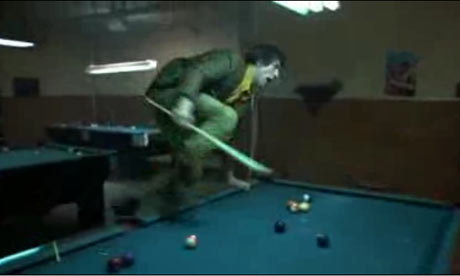 Robert De Niro in Mean Streets. Photograph: Warner Bros
Robert De Niro in Mean Streets. Photograph: Warner Bros
Scorsese's uncanny ear for dialogue was evident from his first masterpiece, Mean Streets, which is set in the heart of Little Italy among debt collectors and small-time hoods. Characters were called by names such as Johnny Boy, Joey Clams and Giovanni Cappa. In one classic pool-hall scene, Robert De Niro, Harvey Keitel and David Proval start a fight - over the jukebox sounds of Please Mr Postman - after a barman calls one of them "a mook".
Goodfellas (1990) Tracking shot entrance to the Copacabana
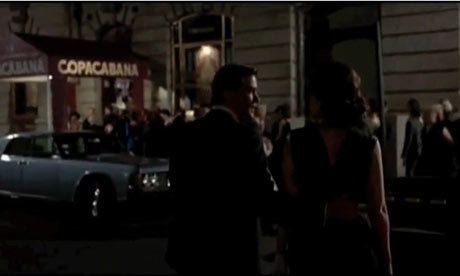 Ray Liotta and Lorraine Bracco in Goodfellas. Photograph: Warner Bros
Ray Liotta and Lorraine Bracco in Goodfellas. Photograph: Warner Bros
Ray Liotta's Henry Hill takes new girlfriend Karen (Lorraine Bracco) to dinner. They enter the Copa via the back door, go through the kitchen and are led onto the dancefloor and to the best table in the house. In one unbroken three-and-a-half minutes' shot, the camera (operated by several times Oscar-nominated Michael Ballhaus) glides with them. "What do you do?" she asks as they sit. "I'm in construction," shrugs Henry, and the shot ends.
Raging Bull (1980) 'I coulda been a contender'
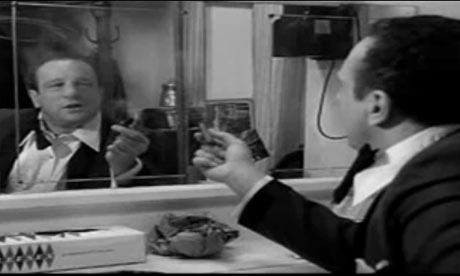 Robert De Niro in Raging Bull. Photograph: Warner Bros
Robert De Niro in Raging Bull. Photograph: Warner Bros
Marty loves a mirror. Travis Bickle asked himself: "You talkin' to me?" in Taxi Driver (1976), and De Niro's bloated washed-up boxer Jake La Motta goes in front of the looking-glass to perform his one-man show, reciting from the works of "Shakespeare, Budd Schulberg and Tennessee Williams". We see the Oscar-winning De Niro, rehearsing his lines, doing Marlon Brando's speech to his brother, from On The Waterfront, and psyching himself up to go on stage, still calling himself "champ".
The Big Shave (1967) The shaving scene
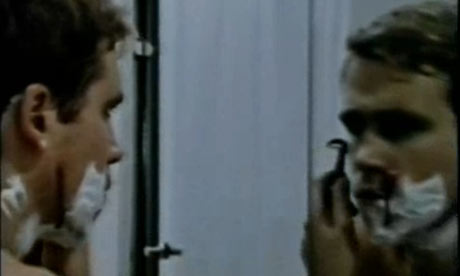 Peter Bernuth in The Big Shave. Photograph: Warner Bros
Peter Bernuth in The Big Shave. Photograph: Warner Bros
Shot for a class at NYU film school, Scorsese's six-minute short features actor Peter Bernuth, yet again in front of a mirror, at a sink, shaving himself closer and closer until he bleeds and blood drips down the plughole recalling the shower scene in Psycho. It's played out over the jazz standard "I Can't Get Started" and has been seen as a metaphor for American involvement in Vietnam, probably because the asthmatic young Scorsese also dubbed it Viet '67.
Round Midnight (1986) Scorsese's cameo
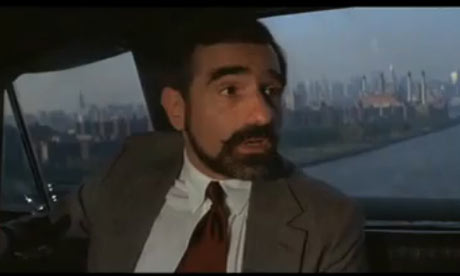 Scorsese himself in Round Midnight. Photograph: Warner Bros
Scorsese himself in Round Midnight. Photograph: Warner Bros
Marty contributes a brilliantly oleaginous cameo as corrupt nightclub owner RW Goodley in Bertrand Tavernier's jazz movie. Goodley greets Dexter Gordon and François Cluzet at JFK and talks incessantly during the cab ride into the city. "New York, for me, the music's better, because it's tougher, the people are tougher," he riffs as they cross the Williamsburg Bridge, framed by Manhattan's skyline. "SOS," says Dexter when Marty finally leaves them. "Same old shit."
Casino (1995) Sharon Stone throwing chips
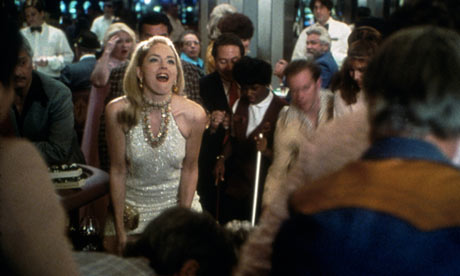 Sharon Stone in Casino. Photograph: SNAP / Rex Features
Sharon Stone in Casino. Photograph: SNAP / Rex Features
One of the director's least appreciated movies, this is the story of Sam "Ace" Rothstein (De Niro) running the mob-owned Tangiers' casino in Las Vegas with his childhood friend Nicky Santoro (Joe Pesci) as an enforcer.
Sam is eventually brought low in this tale of greed and violence by his obsessive love for Sharon Stone's table hustler, Ginger. The film is Stone's finest performance and contains a number of breathtaking shots and sequences. The overhead of her rapturously throwing her chips in the air has become one of the most imitated Vegas scenes.
Academy Awards 2007 Winning an Oscar for The Departed (2006)
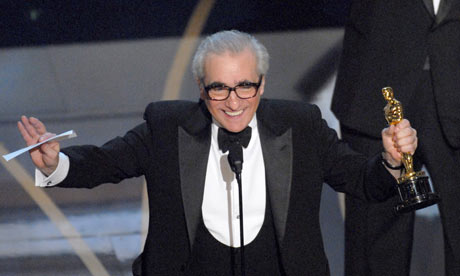 Martin Scorsese accepts best director award for The Departed at the 2007 Academy Awards. Photograph: Getty
Martin Scorsese accepts best director award for The Departed at the 2007 Academy Awards. Photograph: Getty
At the 2007 Academy Awards, Scorsese finally won an Oscar for best director, for his take on the Hong Kong corrupt cop drama, Infernal Affairs. Scorsese's remake is set in Boston. The Departed also won best picture, as well as best adapted screenplay and editing.
Marty had lost out on five previous occasions and it was widely thought Hollywood didn't like him.
To a rousing standing ovation, he received the award from his contemporaries, Steven Spielberg, George Lucas and Francis Ford Coppola.
The King of Comedy (1983) Rupert Pupkin's routine
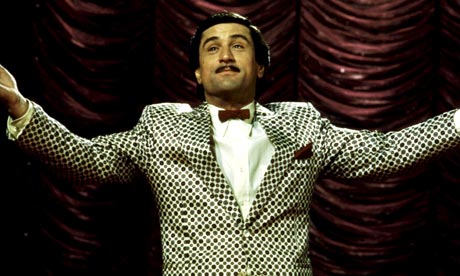 Robert De Niro in King of Comedy. Photograph: Rex Features
Robert De Niro in King of Comedy. Photograph: Rex Features
Having kidnapped Jerry Lewis's TV host Jerry Langford, obsessive stand-up wannabe Rupert Pupkin (De Niro) finally takes to the TV stage as part of his ransom demand, believing his big break has come.
His feeble, miserable, tragic routine - delivered in red trousers, shiny jacket and bow tie - goes down quite well, even when he confesses how he actually got the gig. The audience thinks it's part of the act.
'I figure it this way: better to be king for a night than schmuck for a lifetime,' he closes.
The Red Shoes (2009) Scorsese's restoration work
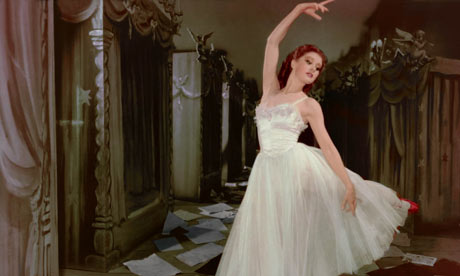 Moira Shearer in The Red Shoes (1948) Photograph: Allstar/Cinetext/RANK
Moira Shearer in The Red Shoes (1948) Photograph: Allstar/Cinetext/RANK
Scorsese's respect for film heritage has led to him overseeing numerous resoration projects, these include founding the World Cinema Foundation to help countries preserve their cinematic treasures and so rediscovering films such as Senegal's Touki Bouki and Morocco's Transes.
Last year at Cannes, he presented a sparkling new print of Michael Powell and Emeric Pressburger's 1948 ballet film The Red Shoes.
Scorsese introduced Powell to his editor Thelma Schoonmaker in New York, and the pair were soon married.
Bad (1987) The Michael Jackson video
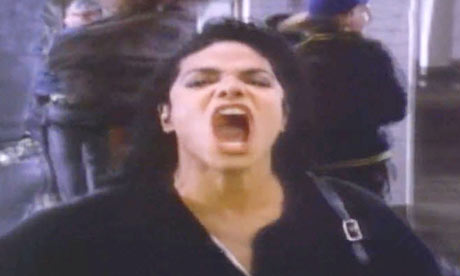 Michael Jackson's Bad video. Photograph: Warner Bros
Michael Jackson's Bad video. Photograph: Warner Bros
Scorsese's love of music - he edited Woodstock in 1970 - has resulted in concert films with the Rolling Stones (Shine A Light) and the Band (The Last Waltz) as well as documentaries about Bob Dylan (No Direction Home) and a series called The Blues.
In 1987 he recreated the choreography from Cool in West Side Story in the video for the title track of Jackson's new album. The dance sequence, set in an underground car park, forms part of an 18-minute short film. It's about expensively educated Daryl (played awkwardly by Jackson) doing a dance to show his old friends 'who's bad'.
Oscars 2010
Oscars 2010: underdog Hurt Locker trounces Avatar
• Kathryn Bigelow is first woman to win best director Oscar
• Avatar gets only three out of nine nominations
• Jeff Bridges, Sandra Bullock, Christoph Waltz and Mo'Nique win acting honours
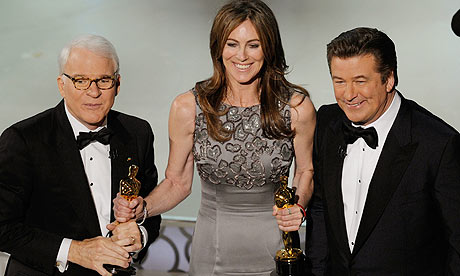
All locked up … Kathryn Bigelow is flanked by Steve Martin and Alec Baldwin after winning the best picture Oscar, joining her Academy Award for best director. Photograph: Kevin Winter/Getty Images
For once, the Oscars were a genuine nail-biter. Right through to the final reel, it was too close to call between the David and Goliath of this year's contenders: Avatar, James Cameron's 3D space opera, and The Hurt Locker, Kathryn Bigelow's low-budget drama about a squad of US bomb disposal experts working in Iraq. That Bigelow and Cameron were once married merely heightened the drama – quietly exploited by the ceremony producers who sat them directly behind each other – as did the huge disparity in their box-office takes (with over $2.6bn, Avatar is the biggest film of all time; The Hurt Locker has just topped $21m).
- The Hurt Locker
- Production year: 2008
- Country: USA
- Cert (UK): 15
- Runtime: 131 mins
- Directors: Kathryn Bigelow
- Cast: Anthony Mackie, Brian Geraghty, Christian Camargo, David Morse, Guy Pearce, Jeremy Renner, Ralph Fiennes
But, in the end, the underdog momentum gathered by The Hurt Locker was just too much for even the mighty Avatar to withstand, despite 11th hour upsets such as the banning of co-producer Nicolas Chartier from the ceremony, and a possible lawsuit in the offing over the film's authorship. The film took six awards, including both best director – making Bigelow the first woman ever to win the award – and best picture, collecting them in such swift succession that Bigelow was left literally breathless.
"It's the moment of a lifetime," she said after being handed the best director prize by Barbra Streisand, who had herself been the first woman to win a directing Golden Globe, for Yentl in 1984. Bigelow dedicated the award to the people of Jordan, where the film was shot, and to the "women and men in the military who risk their lives on a daily basis – may they come home safe". In her speech accepting the best picture award, presented by Tom Hanks, Bigelow extended this to all servicemen and women around the world. The film also took Oscars for Mark Boal's original screenplay, best film editing, sound editing and sound mixing.
Best actor went, predictably, to Jeff Bridges for his role as a washed-up, strung-out country singer in Crazy Heart. The star looked as comfortable ambling onstage as only one raised in the bosom of Hollywood could. His standing ovation was affectionate and deserved.
That accorded to Sandra Bullock, who won the best actress award for her role as a tough-talking woman who takes a troubled football prodigy under her wing in The Blind Side, felt slightly less so. Despite British presence in the category, including rising star Carey Mulligan for An Education and Helen Mirren for her role as Sofia Tolstoy in The Last Station, it was a relatively weak year. But Bullock is a much-loved Hollywood personality, admired as much for her gameness as her acting talents. On Saturday night she had taken to the stage at the Razzies to receive the award for worst actress of the year, for All About Steve, in which she plays a cruciverbalist-turned-stalker.
As expected, the best supporting actor award went to Christoph Waltz, who has so far won every award going in the category for his masterly turn as a sadistic "Jew-hunter" in Inglourious Basterds. But it must have been a blow to Quentin Tarantino that this was the only one of the film's eight nominations that bore fruit (James Cameron's Avatar – nominated in nine categories – did at least go home with three: for art direction, cinematography and visual effects).
Also unsurprisingly, the best supporting actress award went to Mo'Nique, who plays an abusive mother in Precious: Based on the Novel by Sapphire. On the red carpet outside the Kodak theatre, she had been as laissez-faire about the possibility of a victory as only one so heavily-tipped could be: "A win is when someone says [their] life is different because of Precious," she said.
It wasn't the harrowing film's only honour of the evening – there was a surprise in the best adapted screenplay category when Geoffrey Fletcher snatched it from the teeth of An Education's Nick Hornby and Armando Iannucci's In the Loop team. No one was more surprised, it seemed, than Fletcher himself, who struggled through his 45-second address, choked with emotion. "I wrote that speech for him," boasted host Steve Martin directly afterwards – one of many big laughs he and co-host Alec Baldwin received during the evening.
It was a disappointing night for the Brits, especially in the light of last year's Slumdog Millionaire sweep. There was nothing for Colin Firth, Mulligan, Mirren, Hornby or Iannucci. Nothing, even, for Nick Park – usually something of a sure thing at the Oscars, with five already. But in this instance his latest Wallace and Grommit was pipped to the post for best animated short by Nicolas Schmerkin's Logorama.
Also snubbed were the critics' favourites The White Ribbon and A Prophet, which lost out to the Argentinian film The Secret in Their Eyes. But then, when it comes to best foreign language film, the Academy has a history of singing to its own tune.
And, while the ceremony itself began with a full-throttle song-and-dance number, courtesy of TV's Neil Patrick Harris – splendid in a sequinned blazer and accompanied by a bevy of be-feathered dancers – that turned out to be the only song on offer in a ceremony that, though long on glitz, was short on bona fide razzmatazz.
Though winners' acceptance speeches were limited to 45 seconds, it was still a long evening, perhaps a product of the Academy's decision to – after a 67-year hiatus – increase the number of best picture nominees from five to 10. This meant much of the ceremony's running time was devoted to stars introducing clips from the runners and riders and, after their opening routine was complete, surprisingly little time was left to the two hosts. Martin and Baldwin began the night with a healthy dose of celebrity scepticism, dishing out insults of refreshing frankness to the assembled mob. But, as the evening wore on, the poking-of-fun descended into a Mexican wave of genuflection as they, plus guest presenters, succumbed to the pull of actor flattery.
In awarding the first ever best director Oscar to a woman, and the first screenwriting award to an African-American, this was a night of genuine progress and optimism for Hollywood. But the revolution has rarely felt so predictable.
Banksy, Exit through the gift shop
Banksys nya biograf i London
Photos of Banksy's pop-up cinema, Lambeth Palace
See inside the underground venue showing his film, 'Exit Through the Gift Shop'
Ahead of Banksy's exclusive Time Out takeover, we took a look around London's newest, darkest and dirtiest cinema, Lambeth Palace. Situated under hip intersection Waterloo train station and featuring surround sound street art, it will be showing Banksy's film 'Exit Through the Gift Shop' until March 4 (tickets are sold out, more details here)
See next week's Time Out for Banksy's takeover and get your hands on an exclusive new work - yours with every copy of the magazine. Pre-order yours here.
Film director arrested
Film-maker Jafar Panahi arrested in Iran
http://www.guardian.co.uk/film/2010/mar/02/jafar-panahi-arrested-in-iranThe Crimson Gold director, who is a vocal supporter of opposition leader Mir Hossein Mousavi, has reportedly been detained by security forces
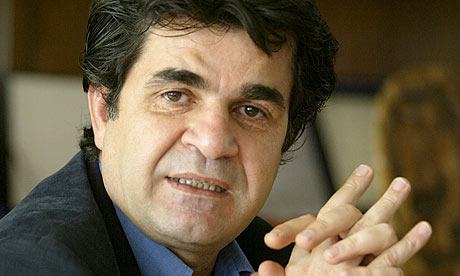
Iranian director Jafar Panahi, photographed in 2004 at his home in Tehran. Photograph: Atta Kenare/AFP/Getty Images
The Iranian director Jafar Panahi has reportedly been detained by security forces in his homeland. Panahi, 49, is a vocal supporter of the opposition leader Mir Hossein Mousavi and has long been regarded as a pariah by the Iranian establishment. He is currently believed to be being held at an undisclosed location.
Mousavi's website Kaleme quotes Panahi's son, who claims that the film-maker was arrested at his home on Monday night, together with his wife, daughter and 15 dinner guests. Security forces allegedly searched the house and seized belongings. The official Iranian media is not reporting the story.
Panahi is known as one of the leading lights of modern Iranian cinema. He won the Camera d'Or award at the Cannes film festival in 1995 for his debut feature The White Balloon and took the Golden Lion prize at Venice for his 2000 drama The Circle. His other films include Crimson Gold and Offside.
Panahi's productions are largely funded by European money as a means of bypassing what he sees as government interference. His films are banned in Iran, where the authorities regard them as implicitly critical of the current regime. "[The authorities] think that anyone who is independent or not following their views is a spy of the west," Panahi told the Guardian at the time of Crimson Gold's release. "Paid by the west. Spreading western propaganda."
The film-maker is known to have criticised the outcome of last year's disputed presidential elections, which returned Mahmoud Ahmadinejad to power and sparked opposition protests across the country. Since then his activities appear to have been curtailed. Last month, organisers of the Berlin film festival claimed that a travel ban had prevented the director from attending the event.

